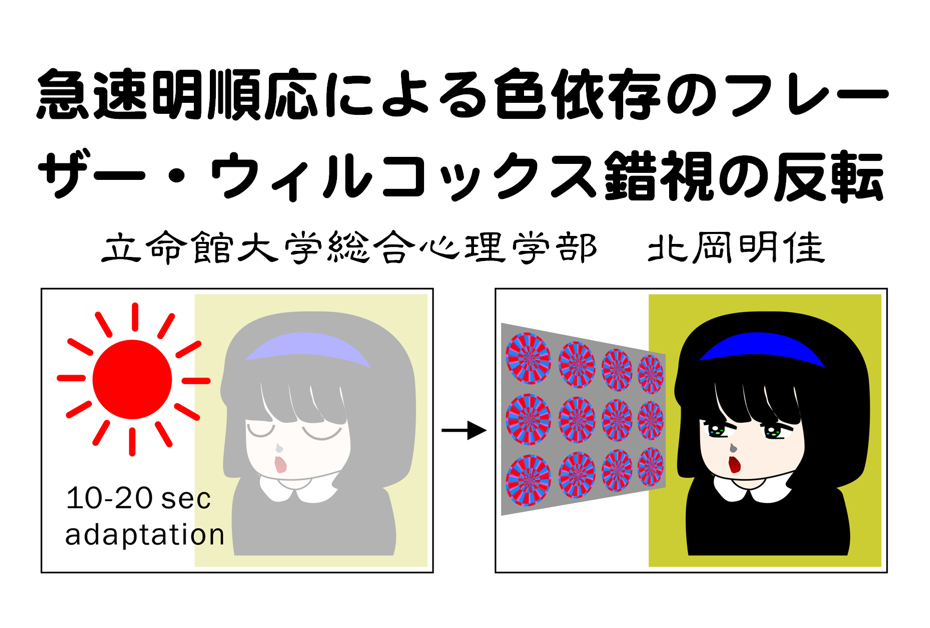
2017年8月30日(水)
立命館大学システム視覚科学研究センター 夏のセミナー2017
立命館大学びわこ・くさつキャンパス(BKC)

"Rotating snakes"
Each disk appears to rotate 'spontaneously' in the constant direction, from black to blue, white, yellow, back to black.
Copyright Akiyoshi Kitaoka 2003 (September 2) (updated February 16, 2013)
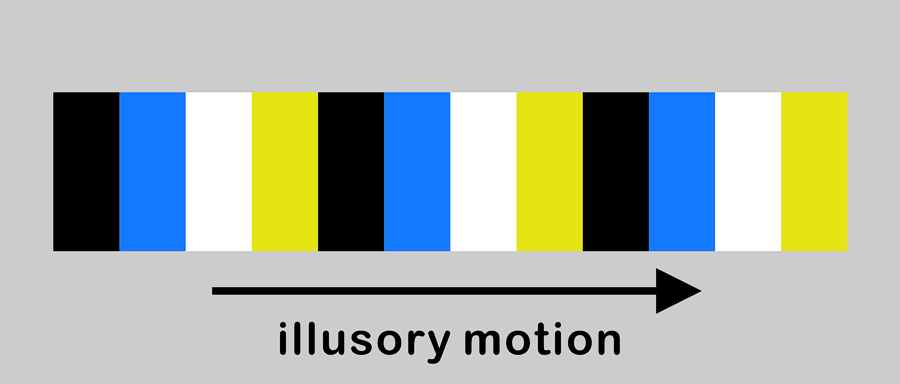
Color is not indispensable. Gray-scale images also work.
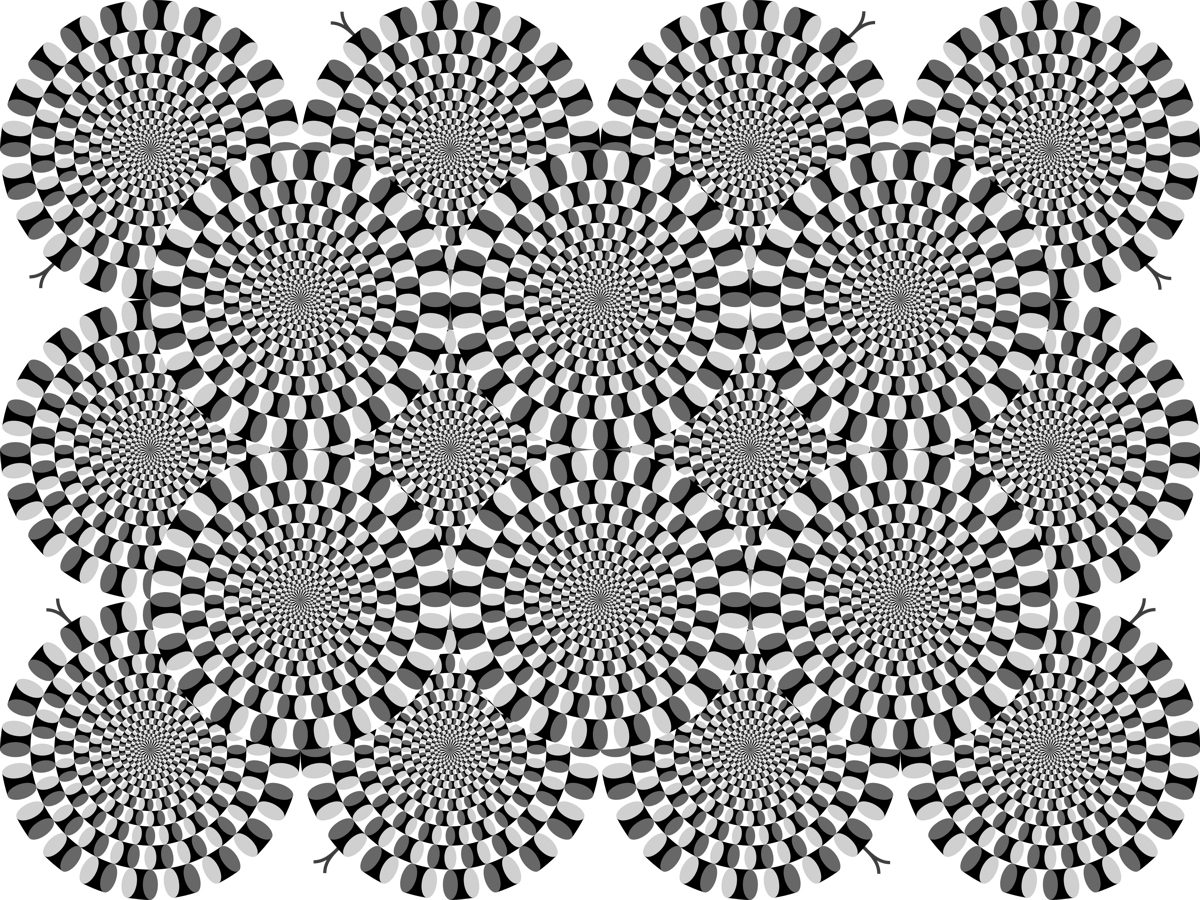
"Rotating snakes: a gray scale version"
Each disk appears to rotate 'spontaneously' in the constant direction, from black to dark gray, white, light gray, back to black.
Copyright Akiyoshi Kitaoka 2013 (May 27)
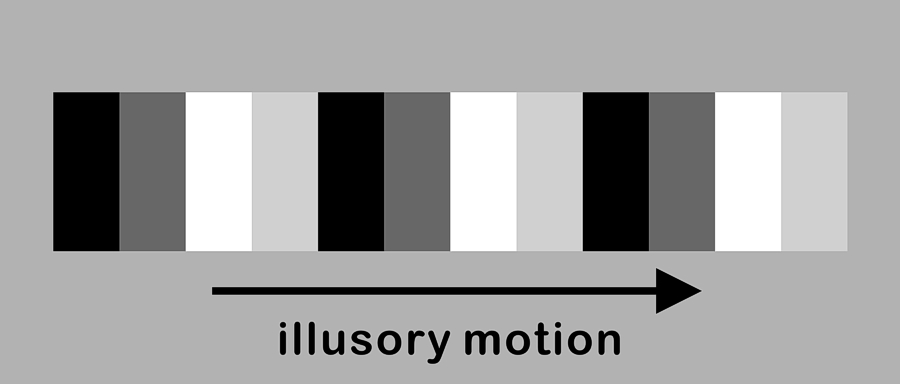
A few years ago I discovered the color-dependent motion illusion.
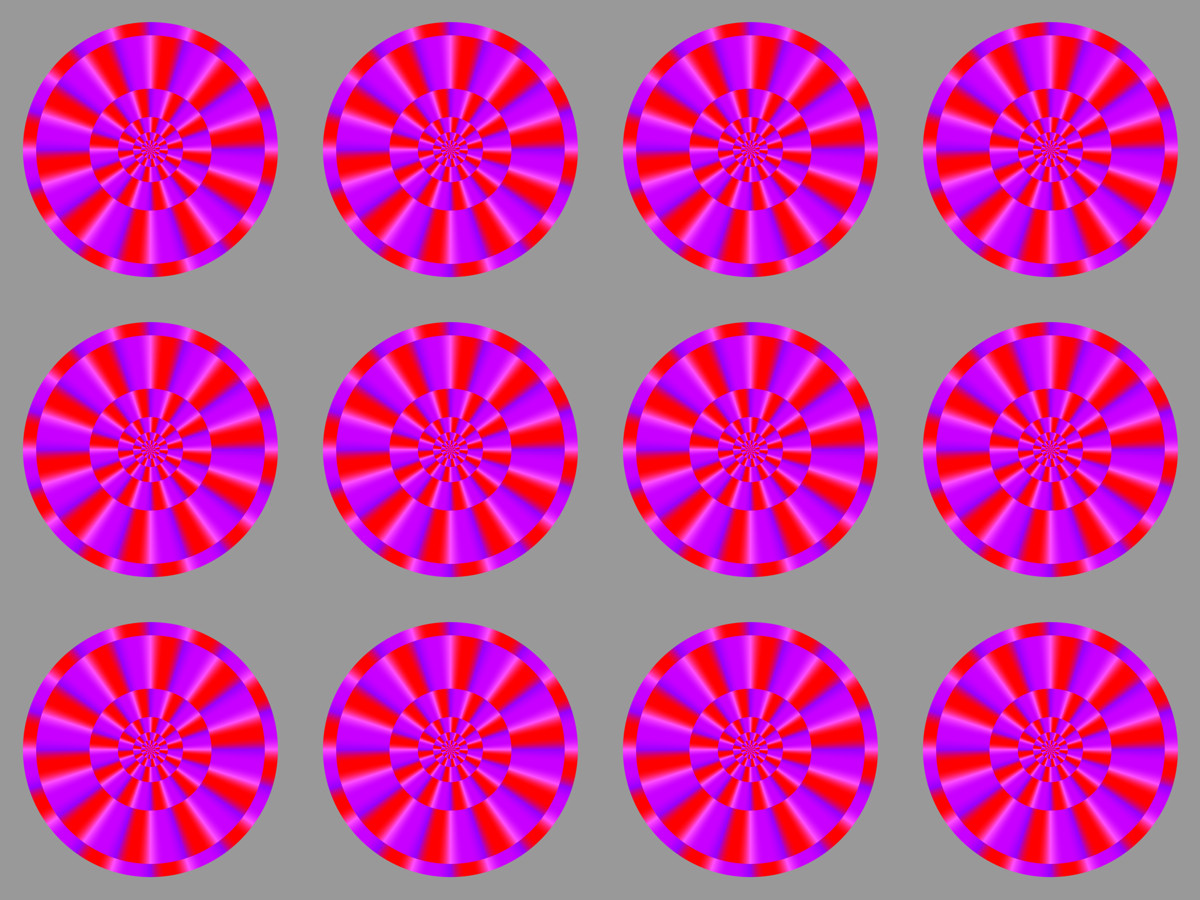
Copyright Akiyoshi Kitaoka 2013 (February 6)
Figure 6 of Kitaoka, A. (2014). Color-dependent motion illusions in stationary images and their phenomenal dimorphism. Perception, 43(9), 914-925.
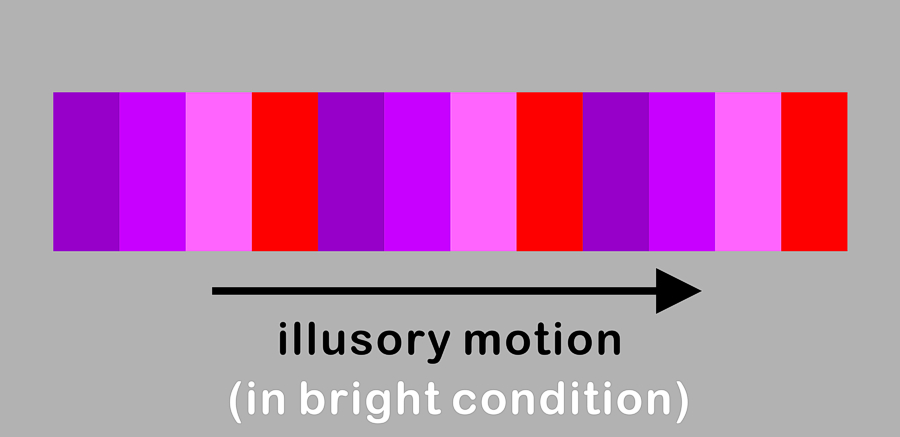
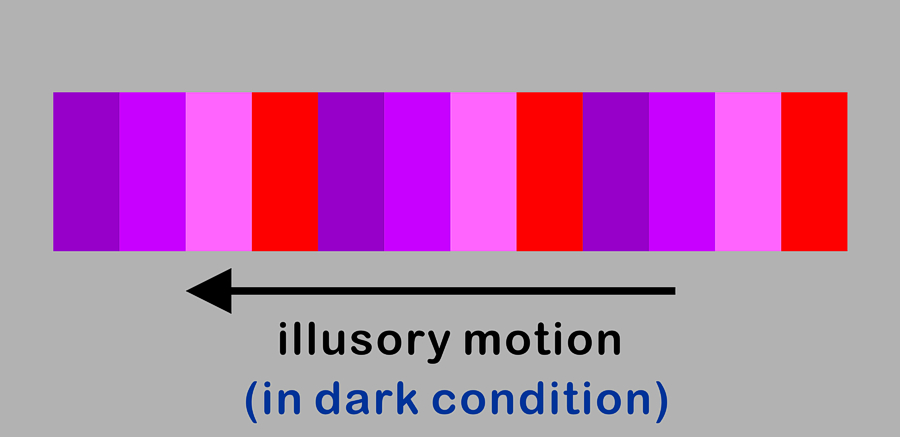
Fraser and Wilcox showed a new phenomenon that stationary disks appear to rotate. They reported bimorphism or bistability of this illusion.
1. Fraser and Wilcox (1979)
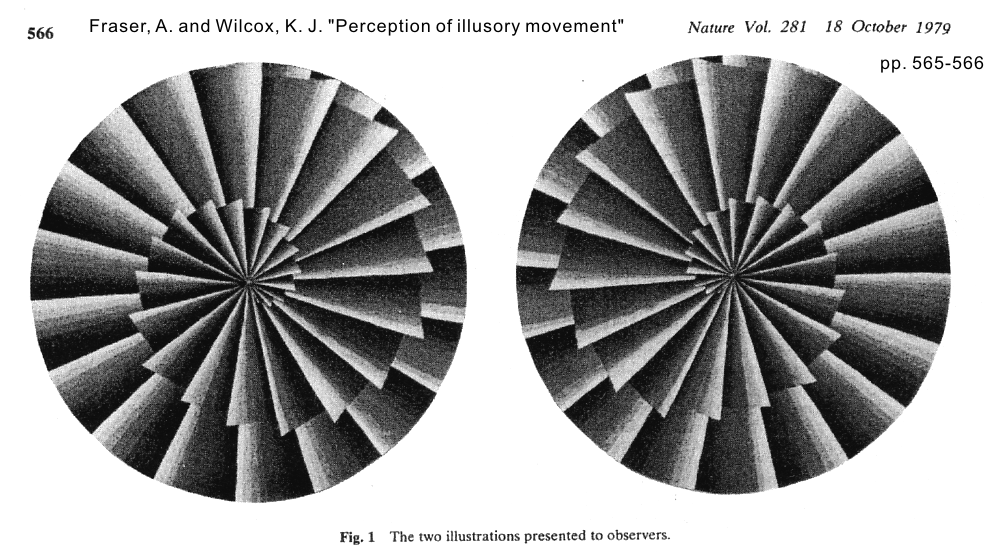
Fraser, A. and Wilcox, K. J. (1979) Perception of illusory movement. Nature, 281, 565-566.
Ambiguity in the direction of illusory rotation
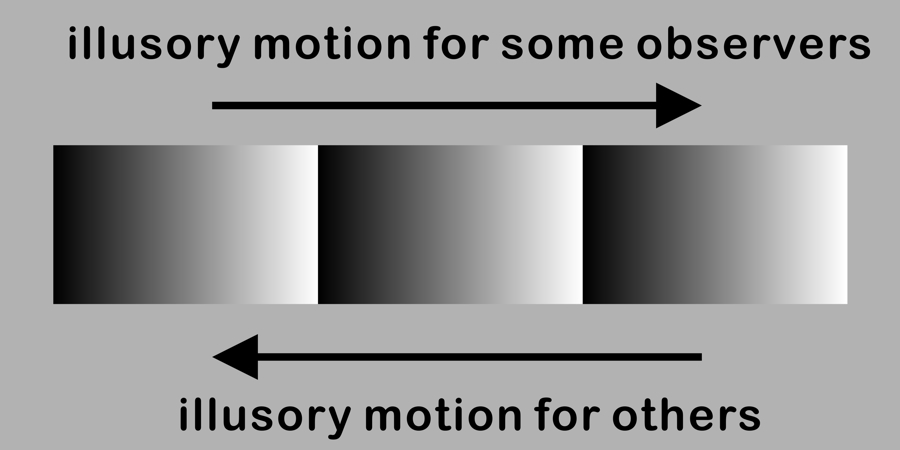
Alex Fraser was a professor of genetics and a painter!
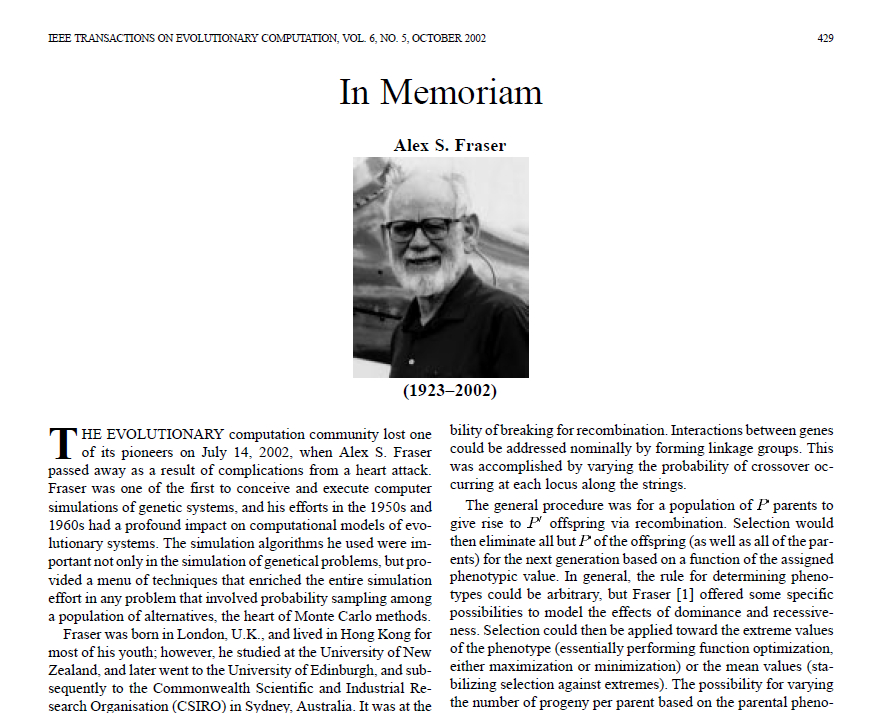
Fogel, D. B. (2002). In Memoriam: Alex S. Fraser (1923–2002). IEEE Transactions on Evolutionary Computation, 6(5), 429-430.
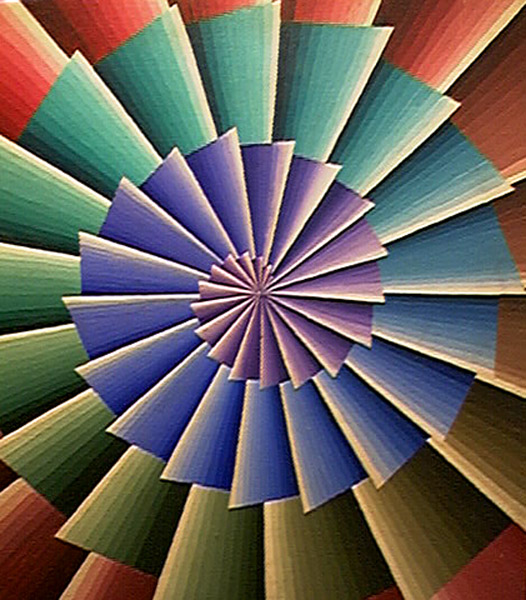
Alex Fraser's original work
Adopted with permission from Alan Fraser (2006) "Alex Fraser, Geneticist and Painter" http://doctoralexfraser.blogspot.jp/
The perceptual bimorphism proposed by Fraser and Wilcox (1979) was not replicated for subsequent two decades.
2. Faubert and Herbert (1999)
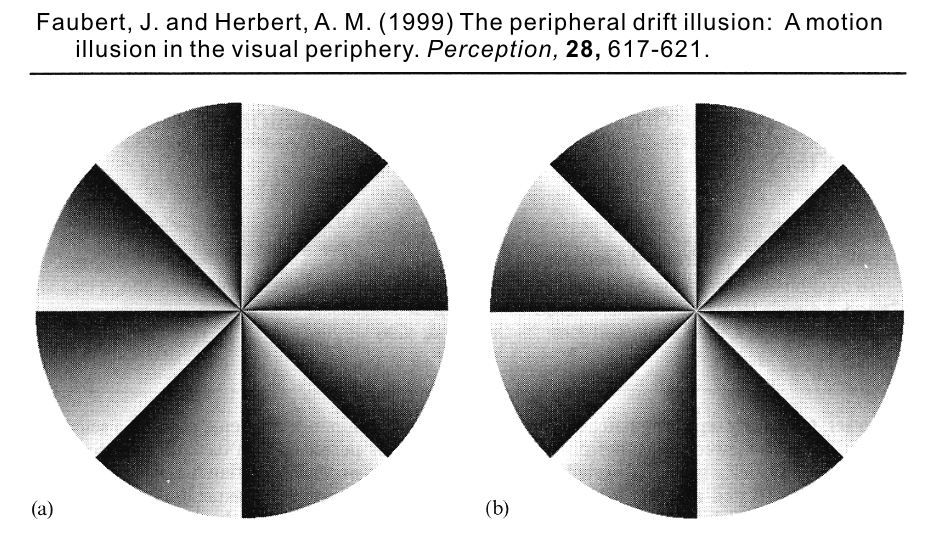
Faubert, J. and Herbert, A. M. (1999) The peripheral drift illusion: A motion illusion in the visual periphery. Perception, 28, 617-621.
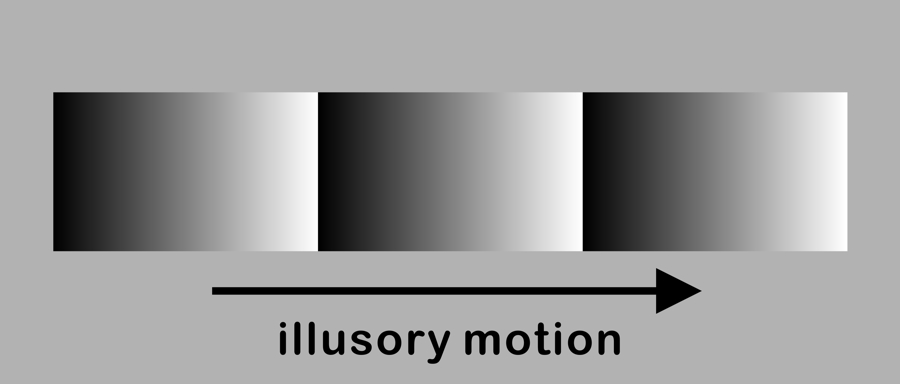
3. Naor-Raz and Sekuler (2000)
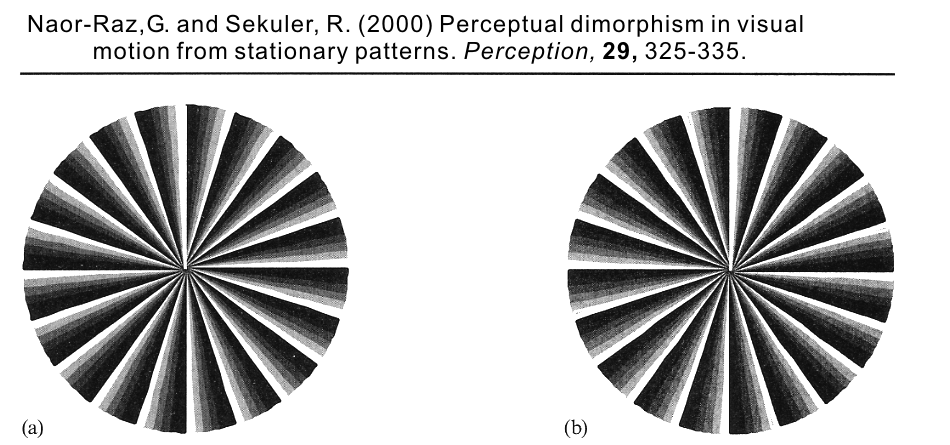
Naor-Raz, G. and Sekuler, R. (2000) Perceptual dimorphism in visual motion from stationary patterns. Perception, 29, 325-335.
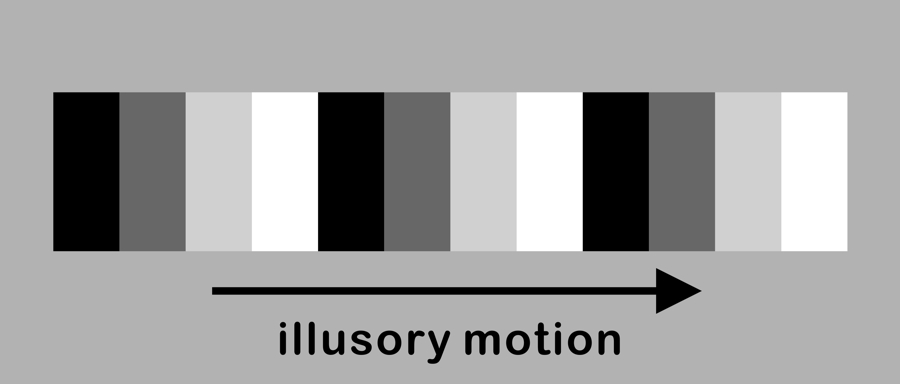
We separated two illusions that cancel each other and proposed the optimized Fraser-Wilcox illusion.
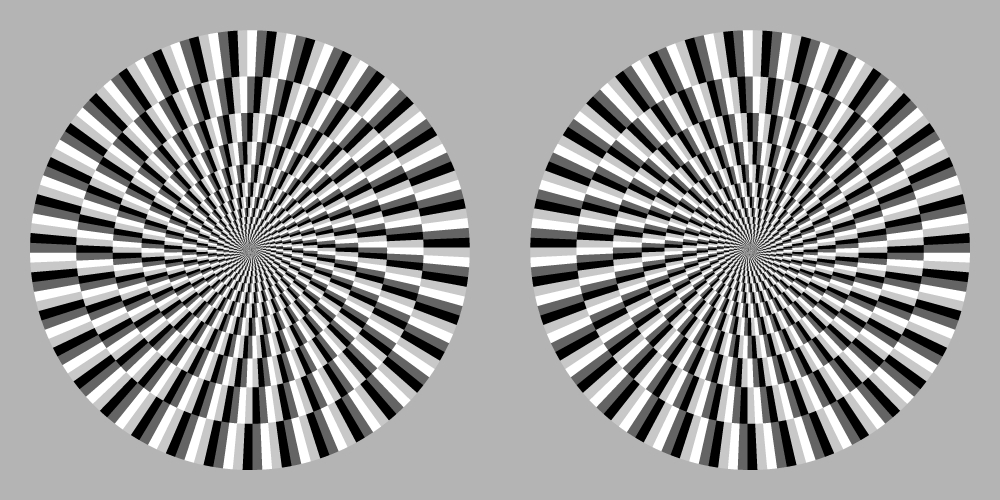
Kitaoka, A. and Ashida, H. (2003) Phenomenal characteristics of the peripheral drift illusion. VISION (Journal of the Vision Society of Japan), 15, 261-262. PDF

Two illusion are cooperatively combined.
There are a few types of the optimized Fraser-Wilcox illusion.
Luminance gradient type (Type I)

The left disk appears to rotate counterclockwise while the right one clockwise.
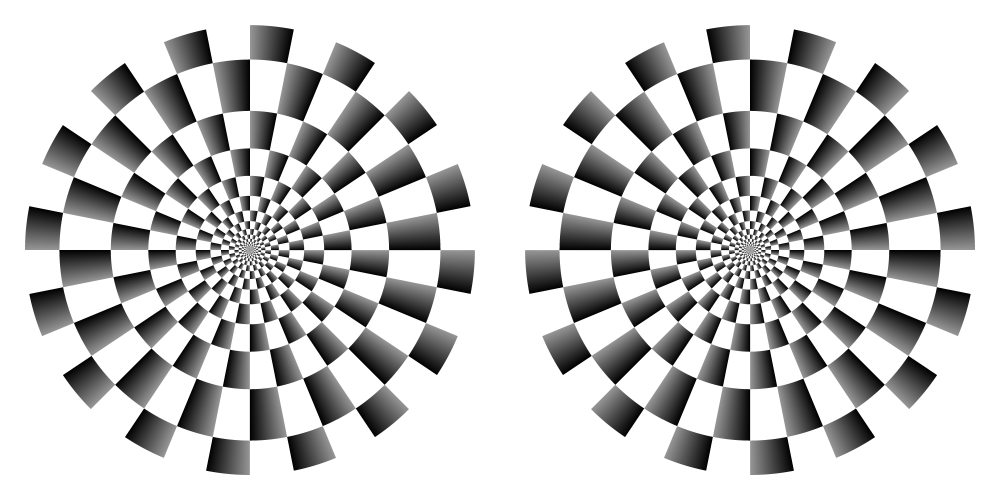
"Dark to light"
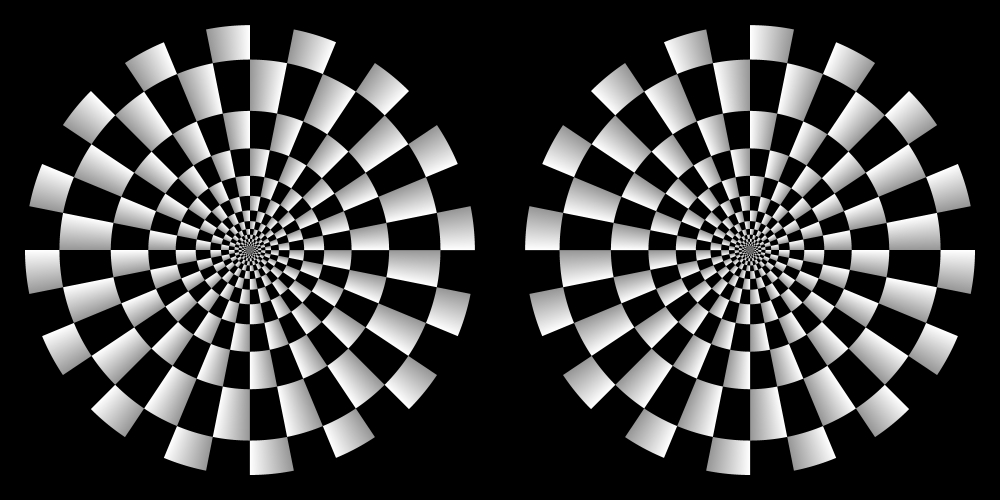
"Light to dark"
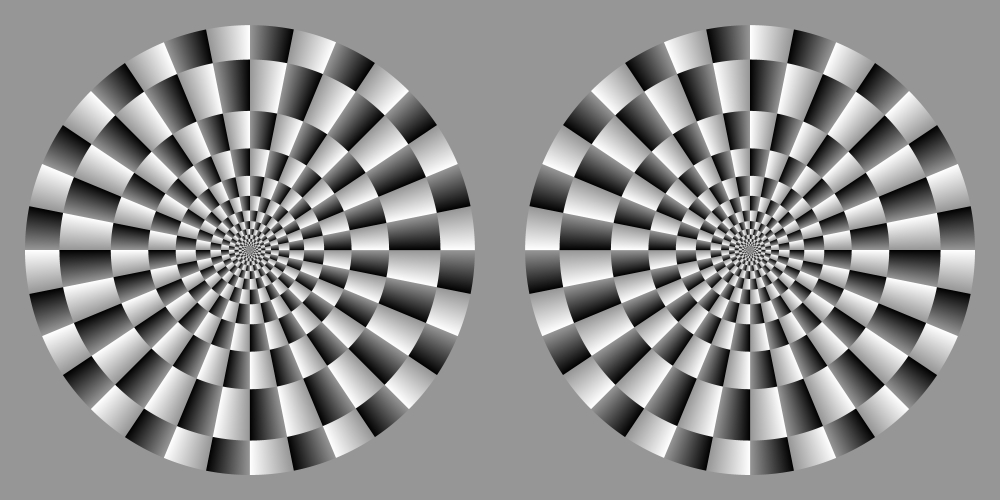
"Dark to light" and "Light to dark"
are combined, giving a stronger illusion
Color enhances illusion.
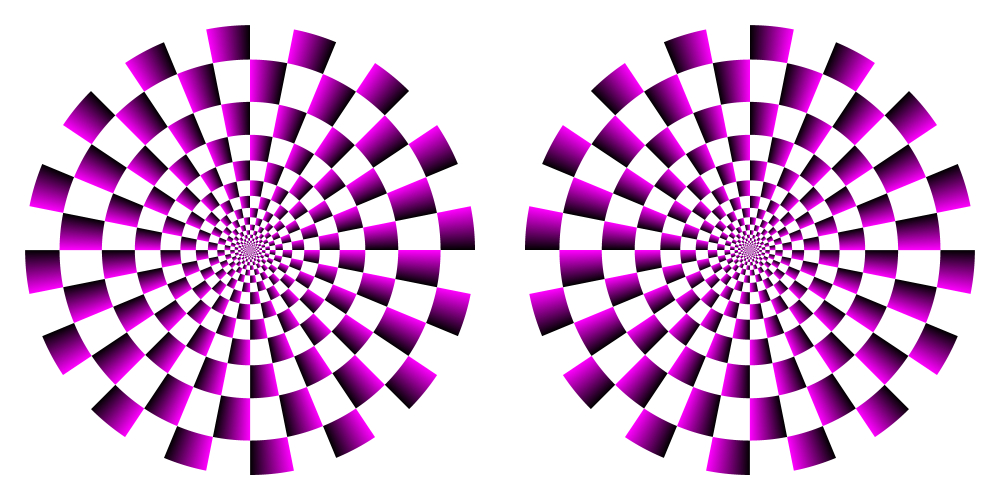
The illusion from dark to light is enhanced by red or blue.
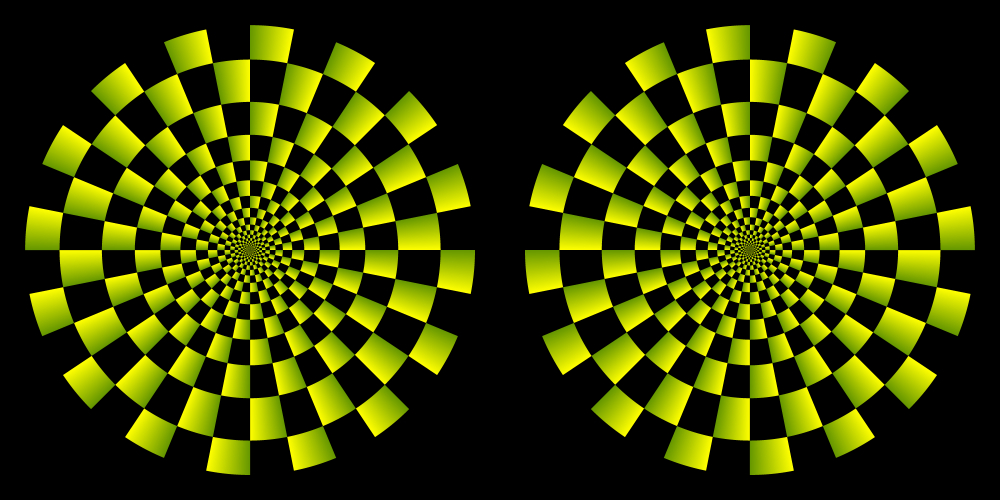
The illusion
from light to dark is enhanced by yellow or green.
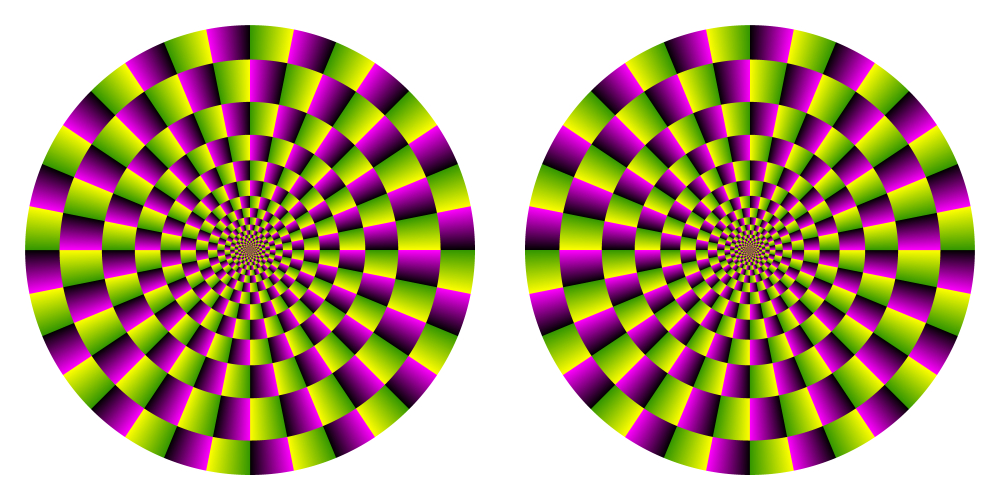
Both illusions work additively.
<Example> The upper-left, upper-right, and lower-middle disks appear
to rotate counterclockwise while the rest clockwise.
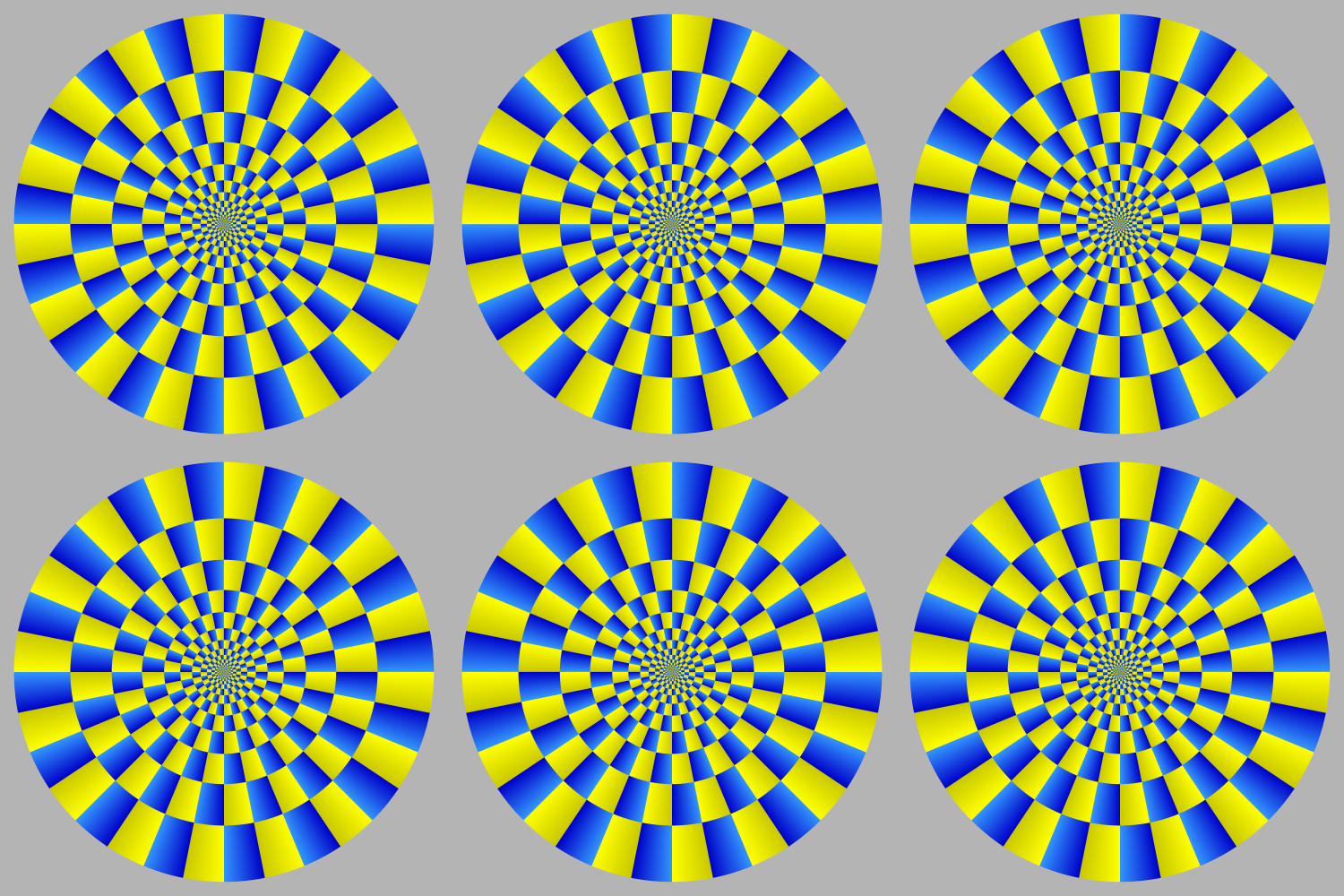
Luminance step type (Type II)
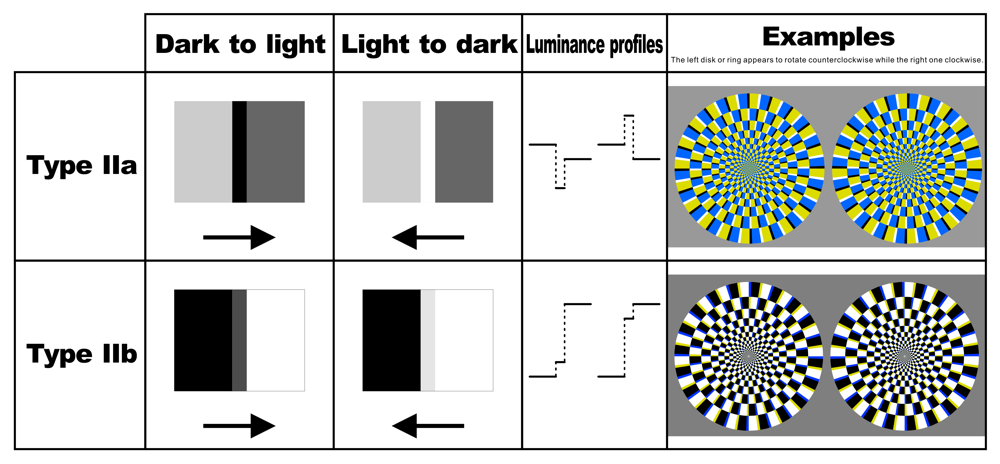
<Example> The upper-left, upper-right, and lower-middle disks appear
to rotate counterclockwise while the rest clockwise.
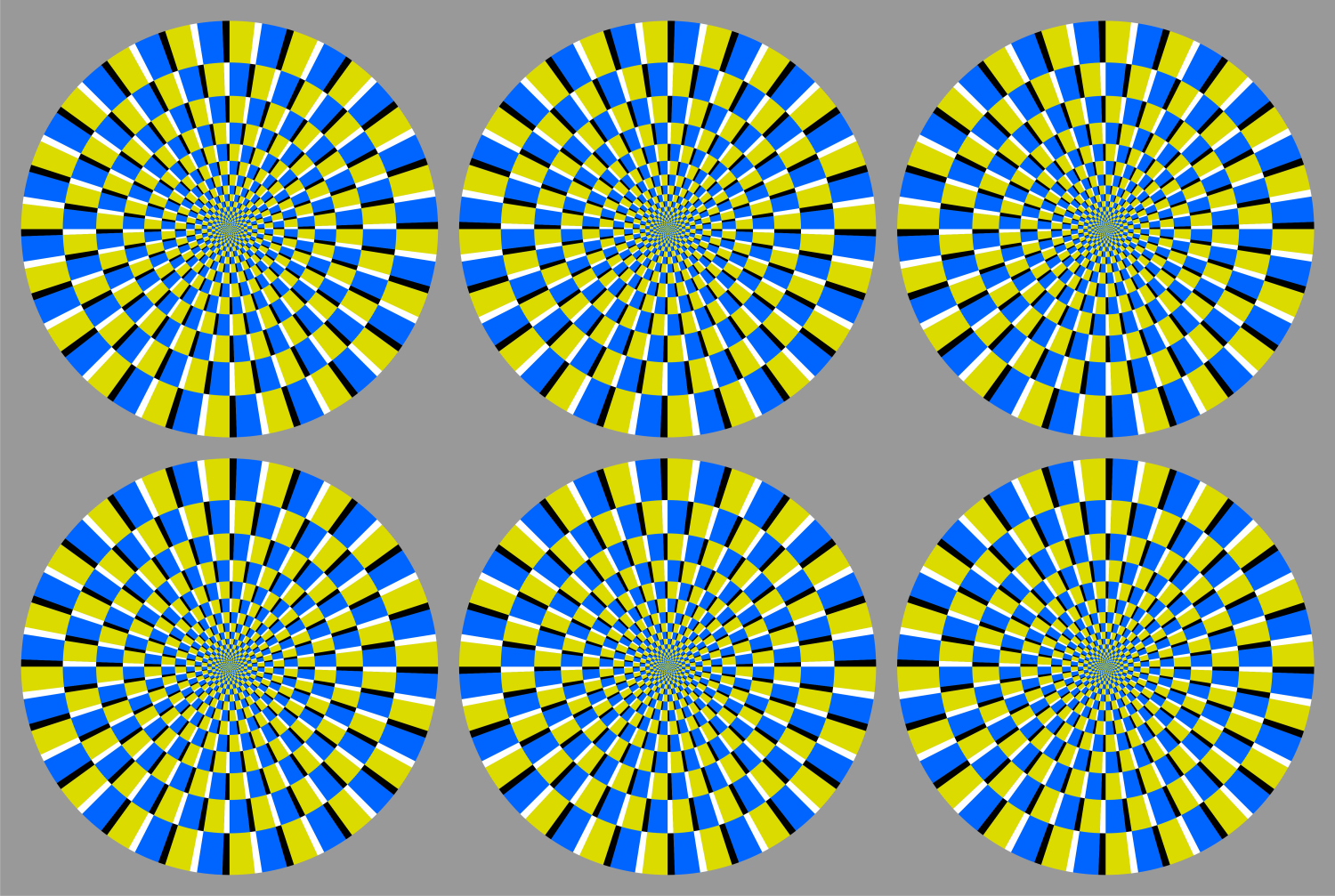
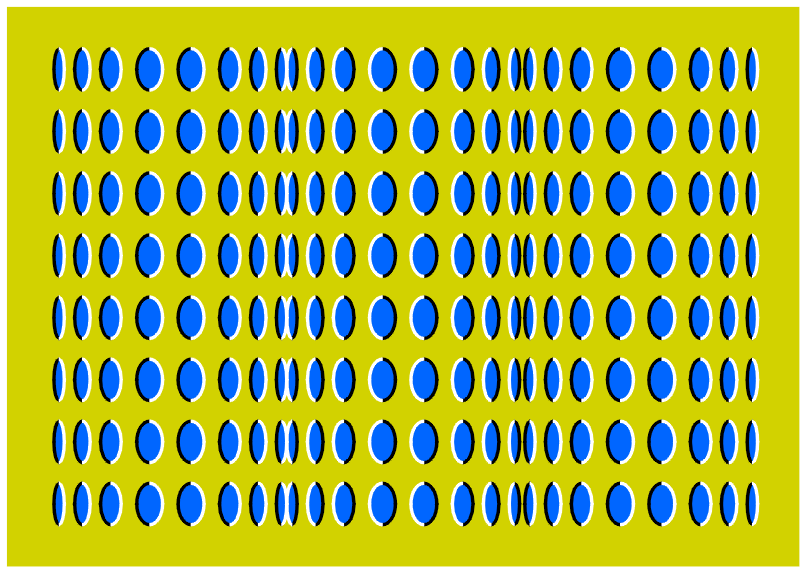
"Rollers"
Rollers appear to rotate without effort. On the other hand, they appear to rotate in the opposite direction when observers see this image keeping blinking.
Copyright A.Kitaoka 2004 (April 20)
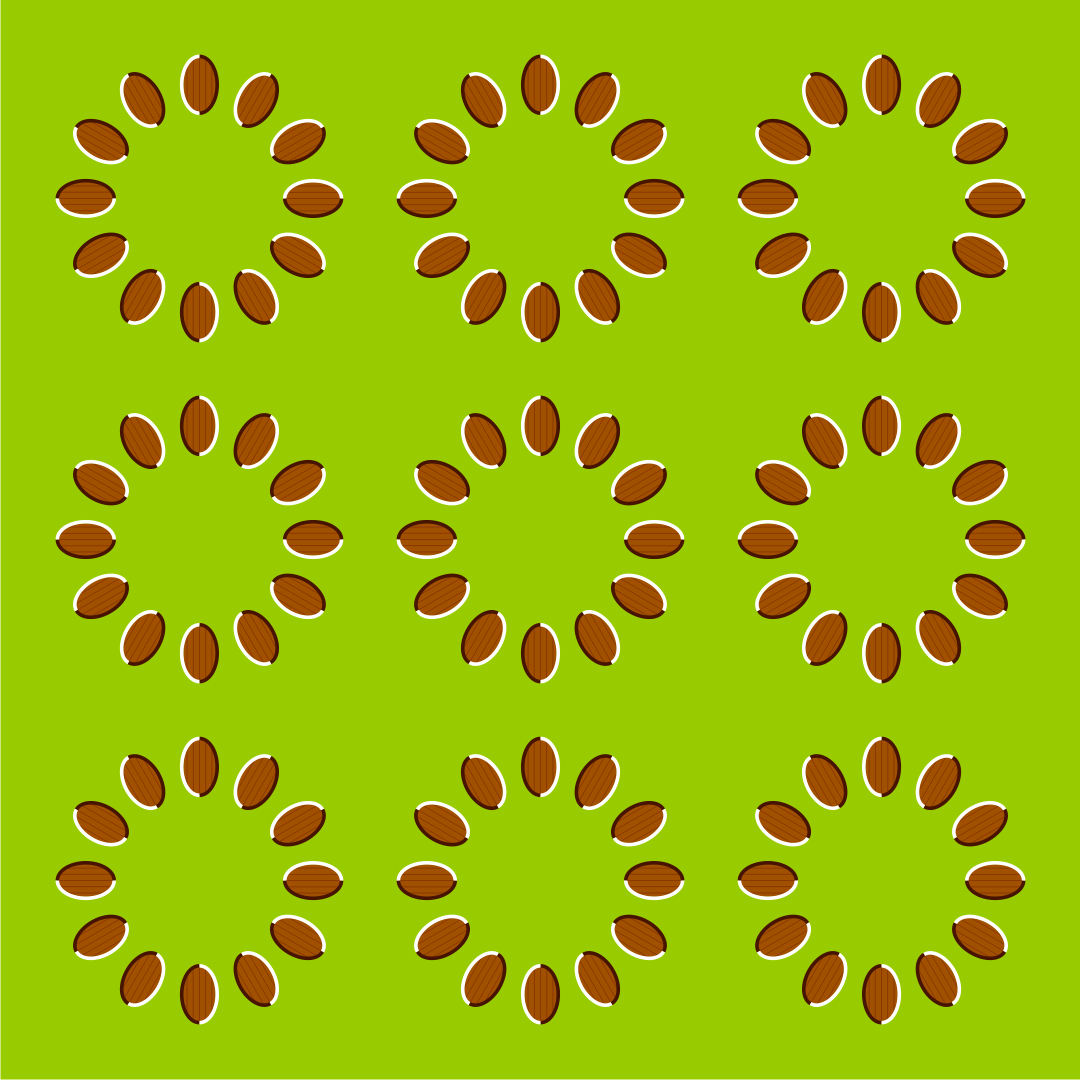
"Dongururin"*
*Rotation of donguri (acorns). "Gururin" means rotation.
Rings of donguri appear to rotate.
Copyright A.Kitaoka 2003 (July 3, 2003)
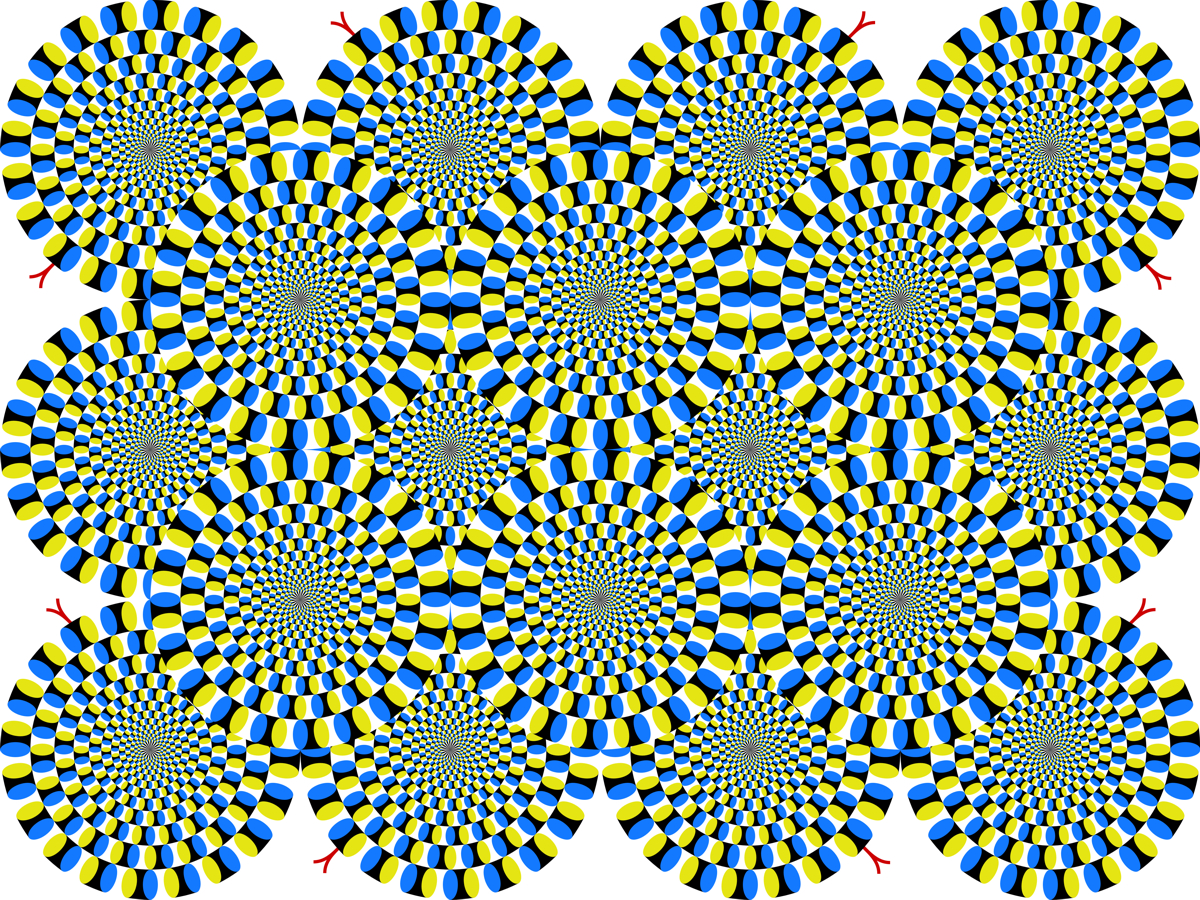
"Rotating snakes"
Each disk appears to rotate 'spontaneously' in the constant direction, from black to blue, white, yellow, back to black.
Copyright Akiyoshi Kitaoka 2003 (September 2) (updated February 16, 2013)
Age and illusion
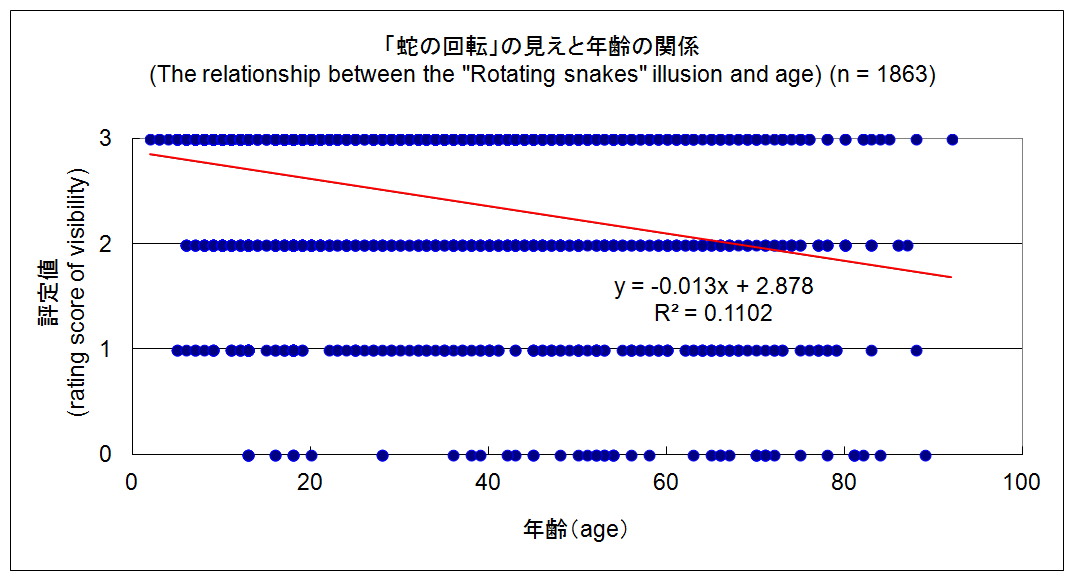
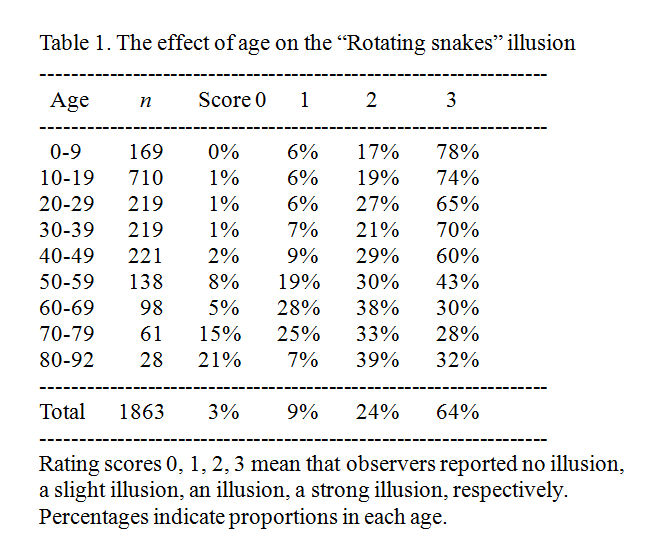
Another luminance step type (Type III)

<Example> The upper-left, upper-right, and lower-middle disks appear
to rotate counterclockwise while the rest clockwise.
.jpg)
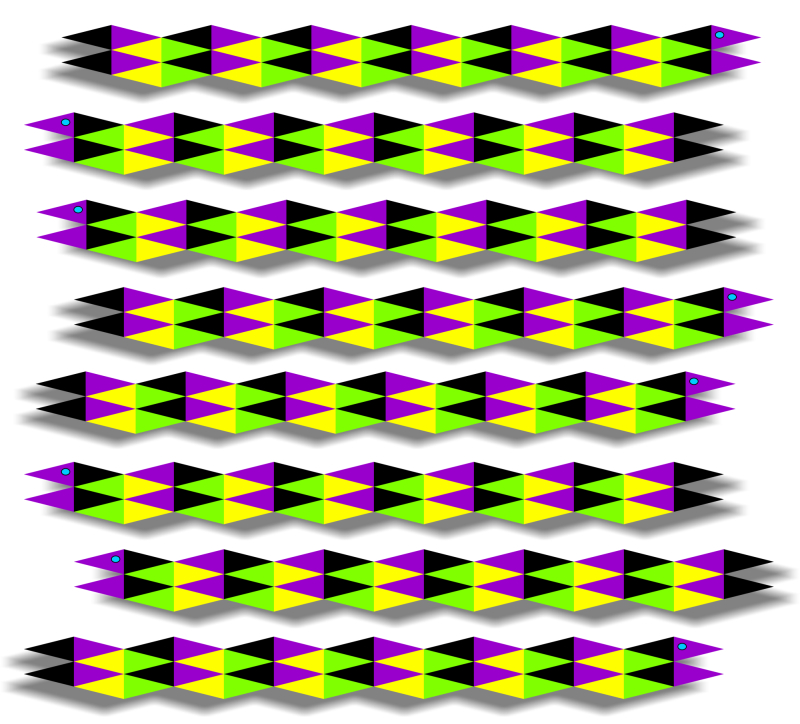
"Moving snakes with shadows"
Snakes appear to move horizontally.
Copyright Akiyoshi Kitaoka 2009 (June 7)
Highlight and shadow type (Type IV)

<Example> The upper-left, upper-right, and lower-middle disks appear
to rotate counterclockwise while the rest clockwise.
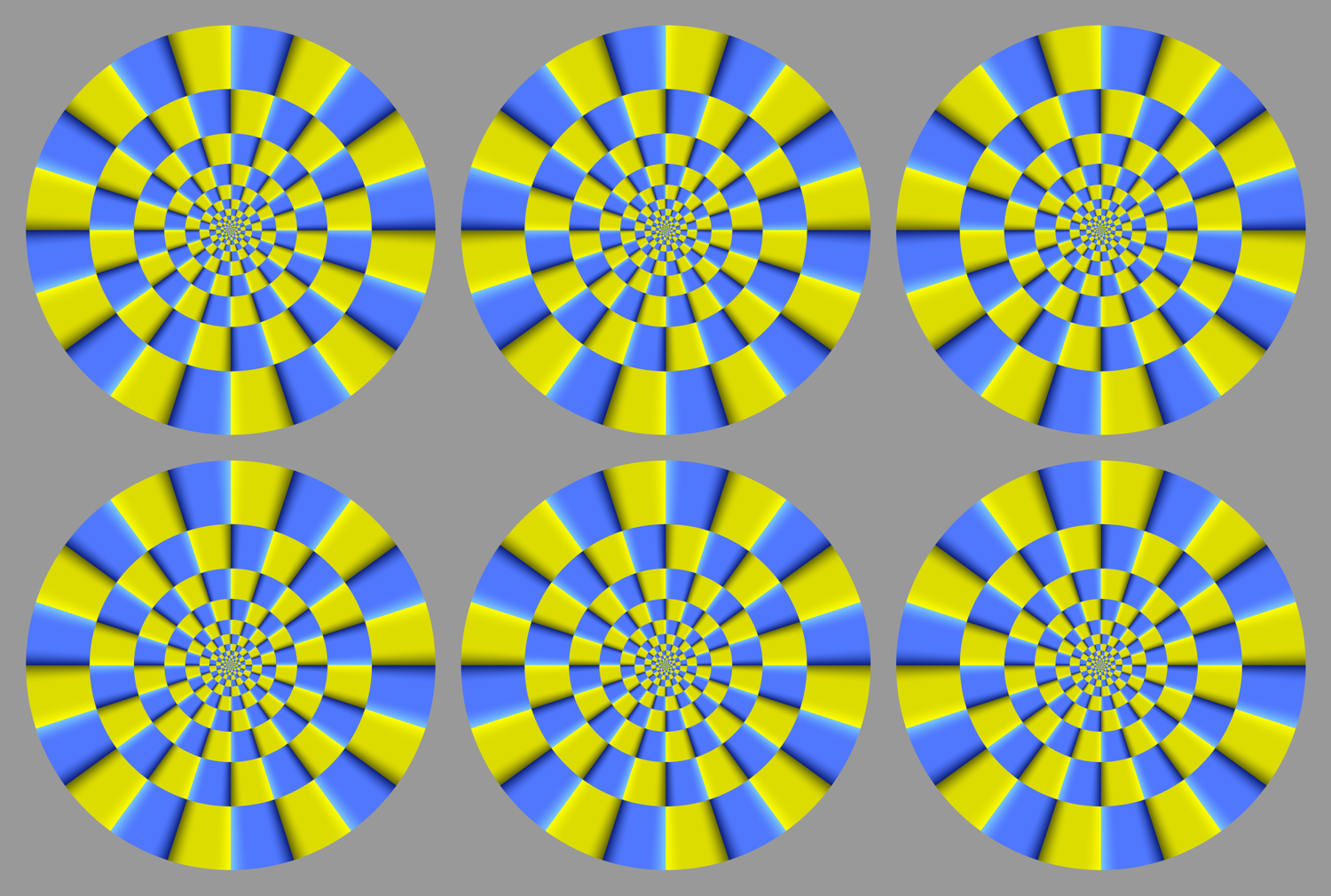
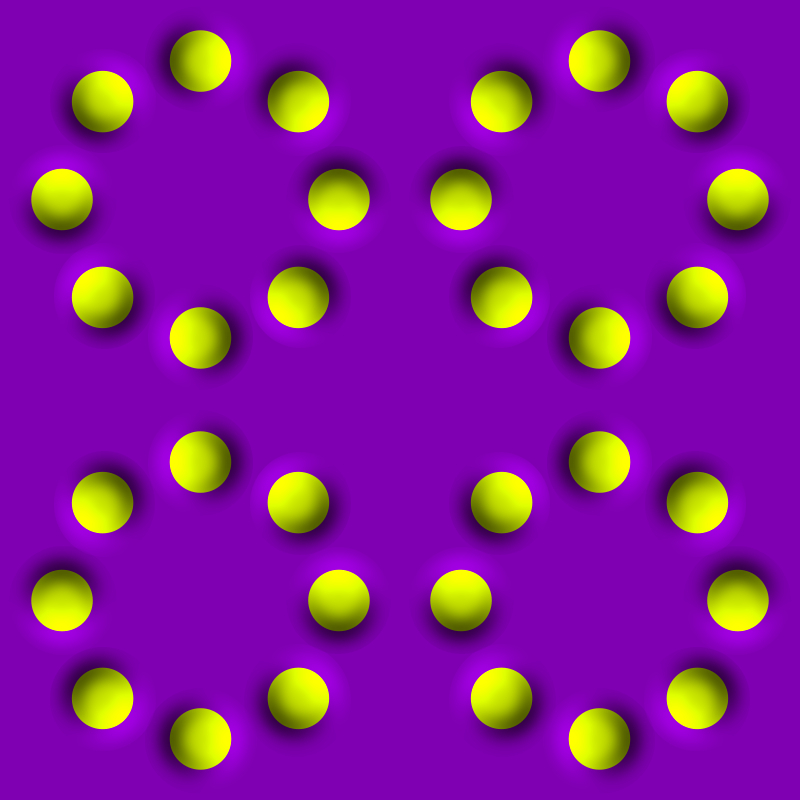
"Rotating tablets"
Rings appear to rotate.
Copyright Akiyoshi Kitaoka 2011 (July 14)
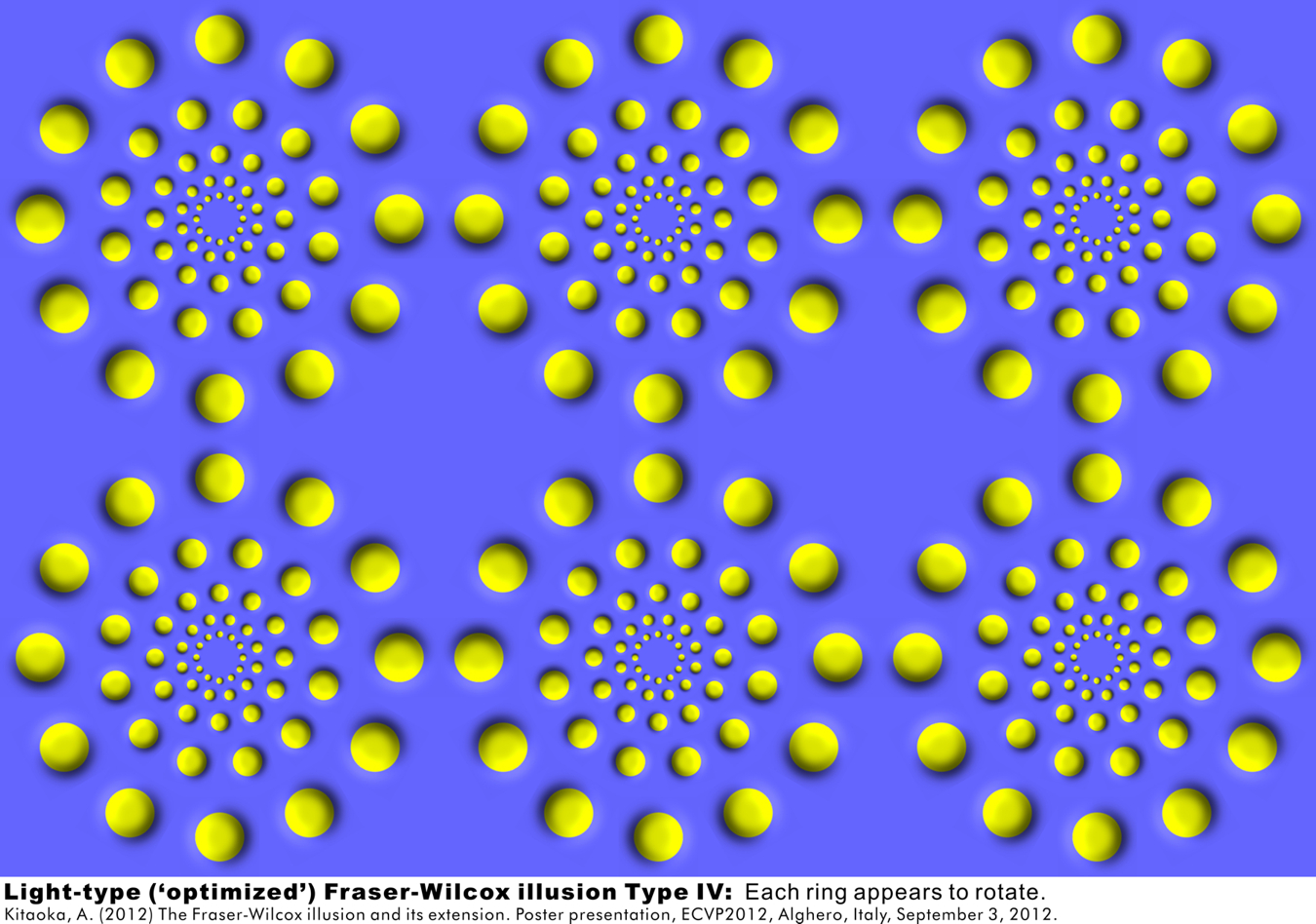
Dark type
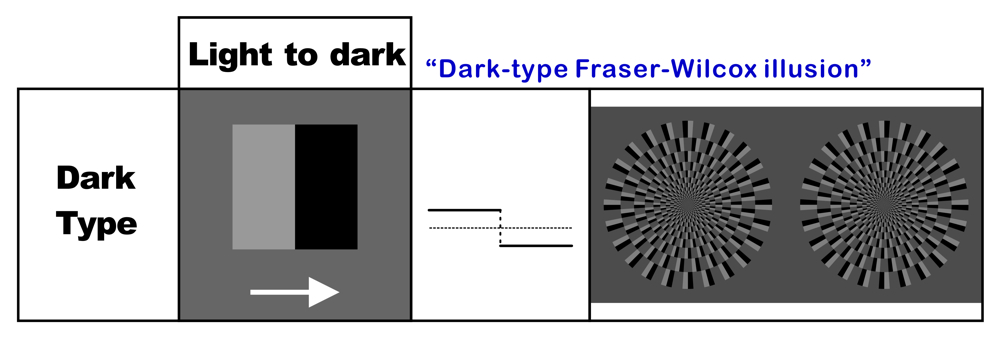
<Example> The upper-left, upper-right, and lower-middle disks appear
to rotate counterclockwise while the rest clockwise.
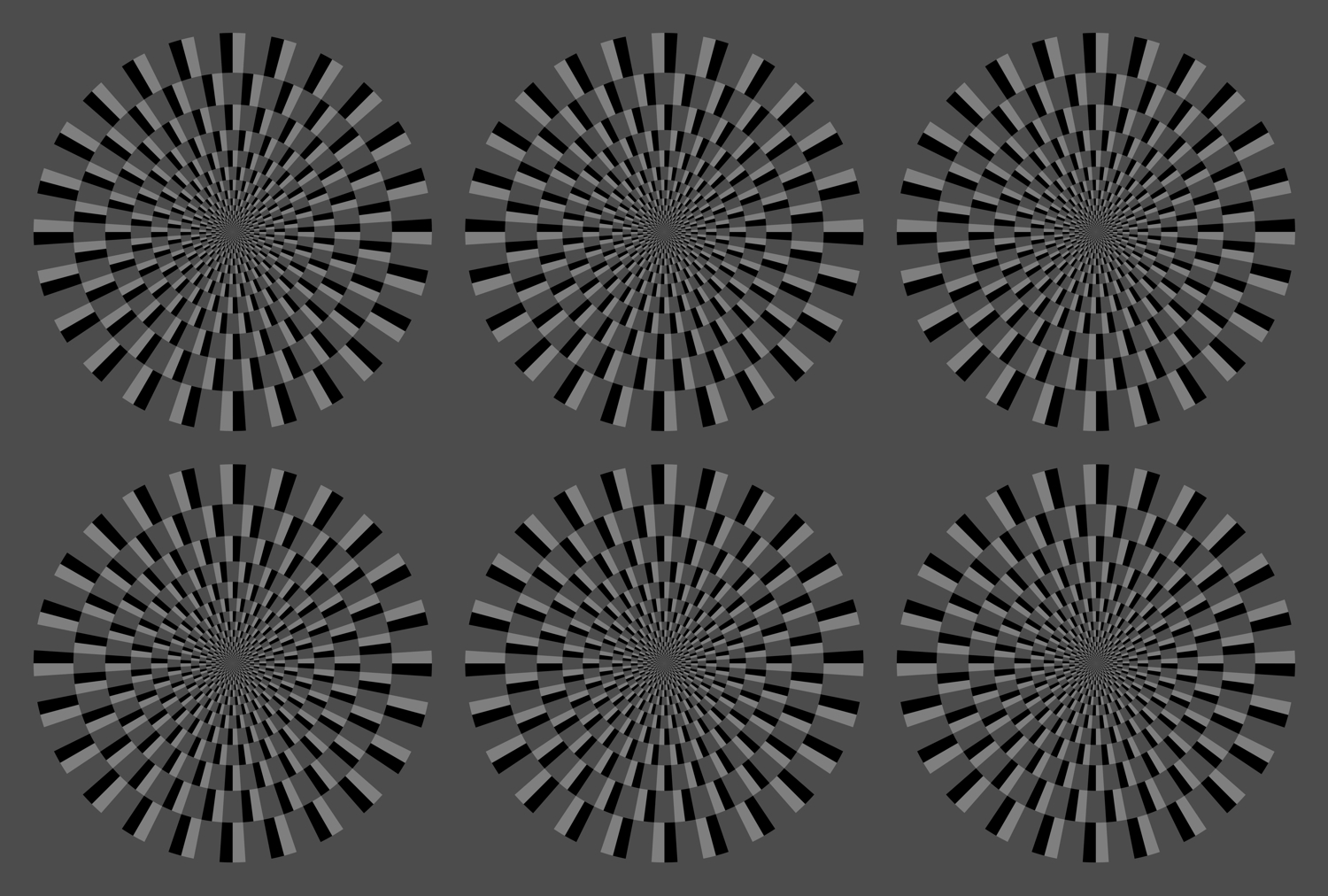
Kitaoka, A. (2012). The Fraser-Wilcox illusion and its extension. Perception 41 ECVP Abstract Supplement, page 91 (Poster September 3, 2012). Poster PDF
Copyright Robert Sekuler
Exception of the dark type
(kind of color-dependent type)
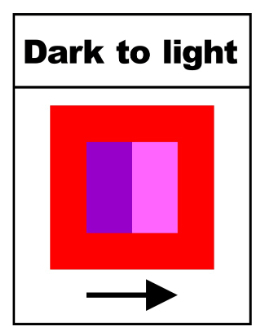
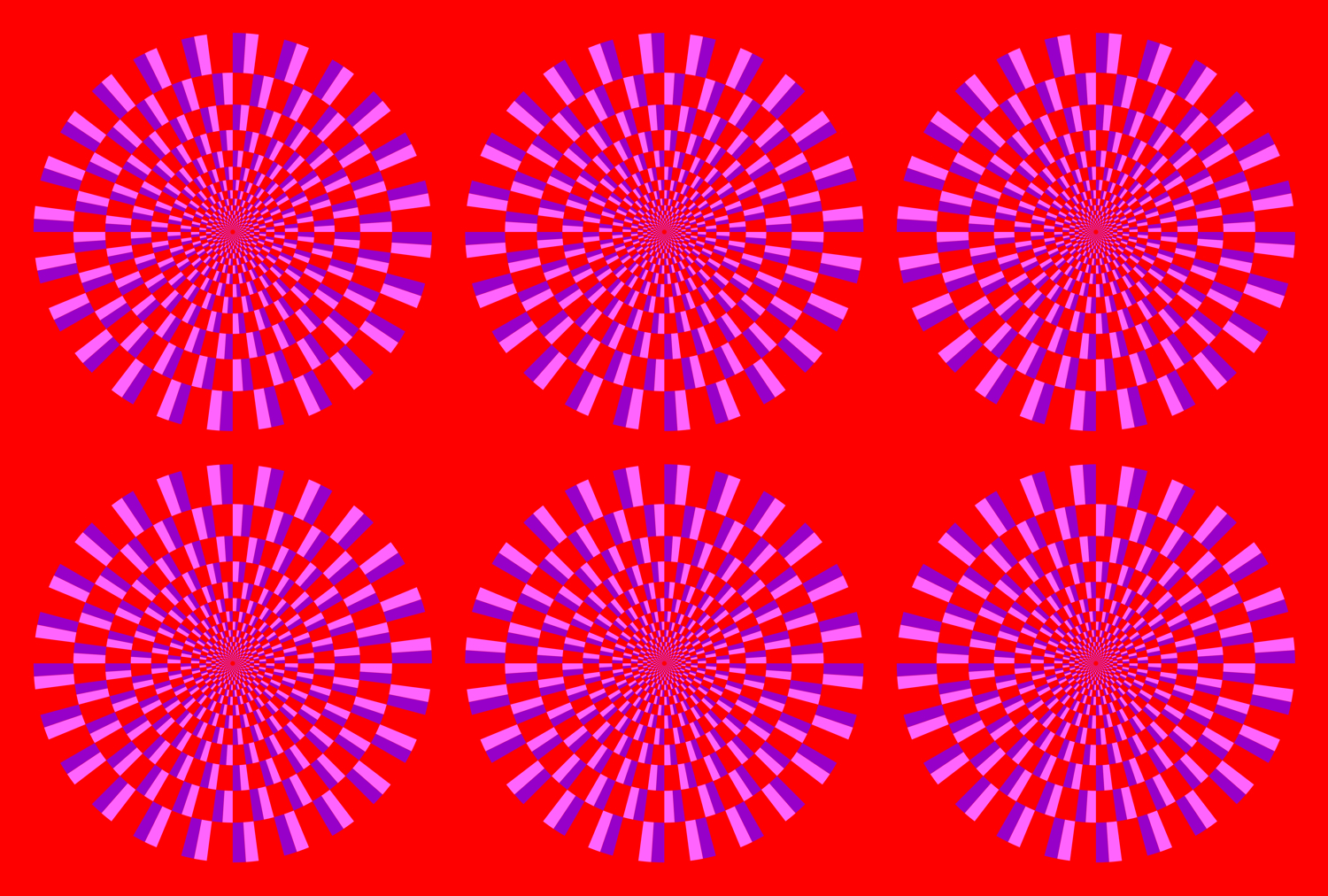
Kitaoka, A. (2012). The Fraser-Wilcox illusion and its extension. Perception 41 ECVP Abstract Supplement, page 91 (Poster September 3, 2012). Poster PDF
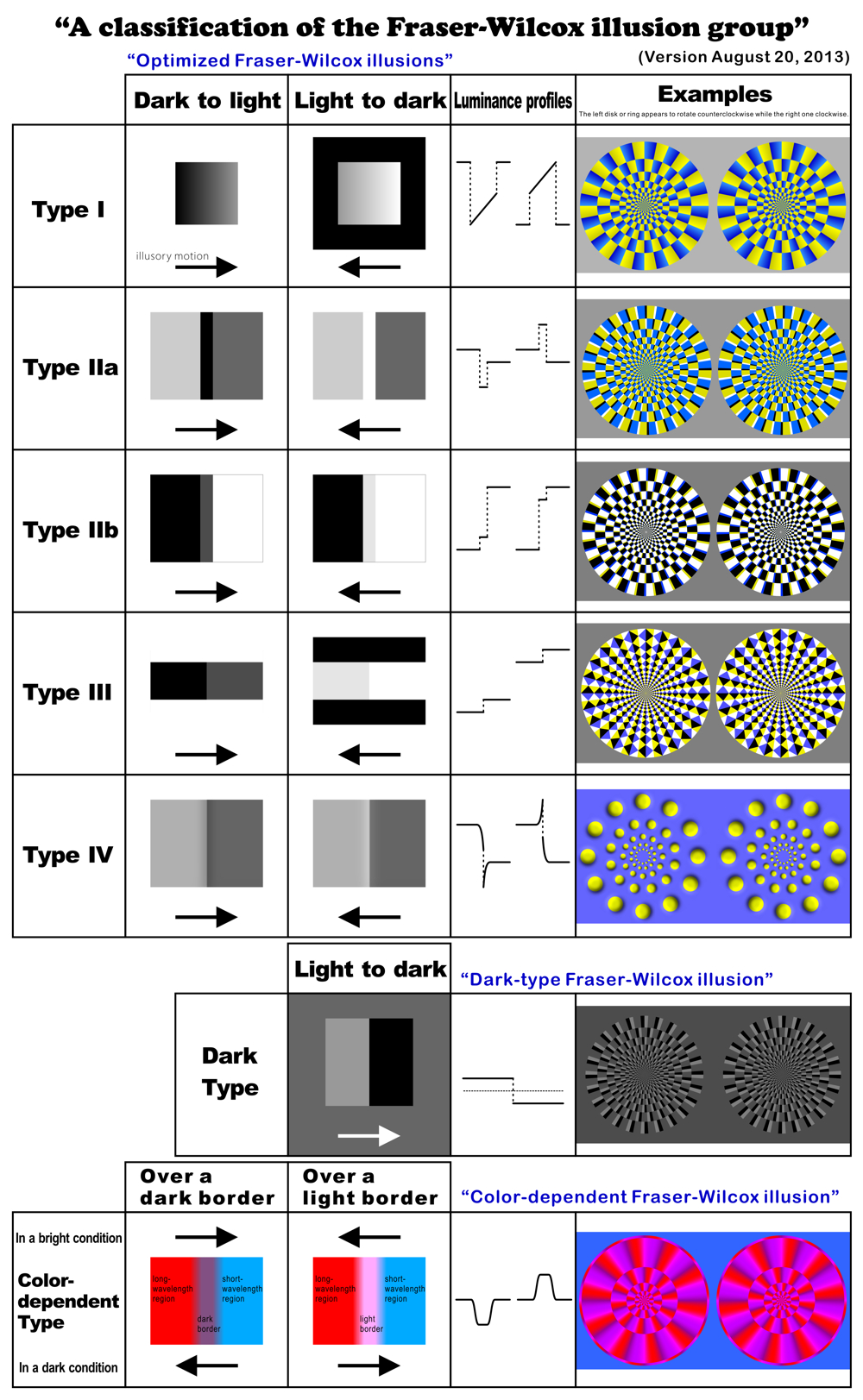
Color-dependent type

Kitaoka, A. (2014). Color-dependent motion illusions in stationary images and their phenomenal dimorphism. Perception, 43(9), 914-925.
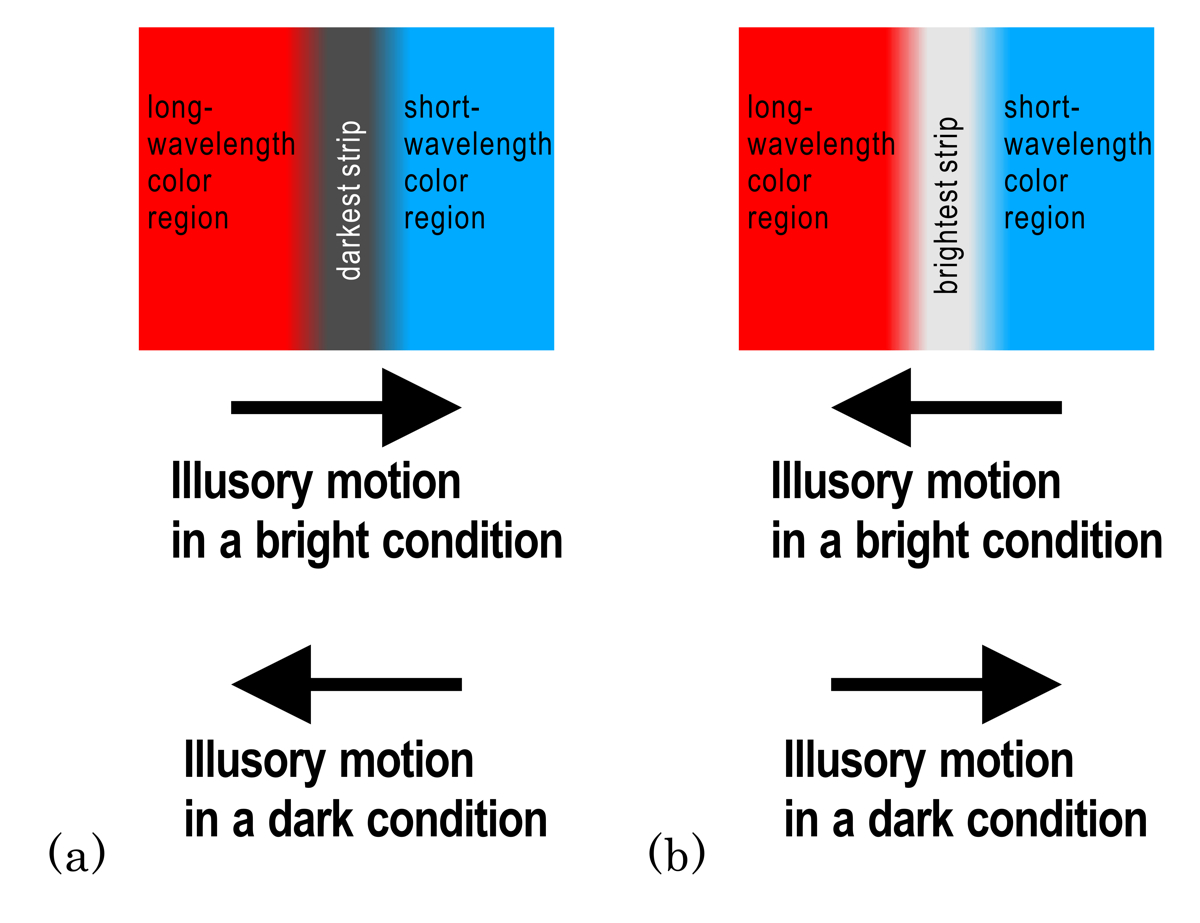
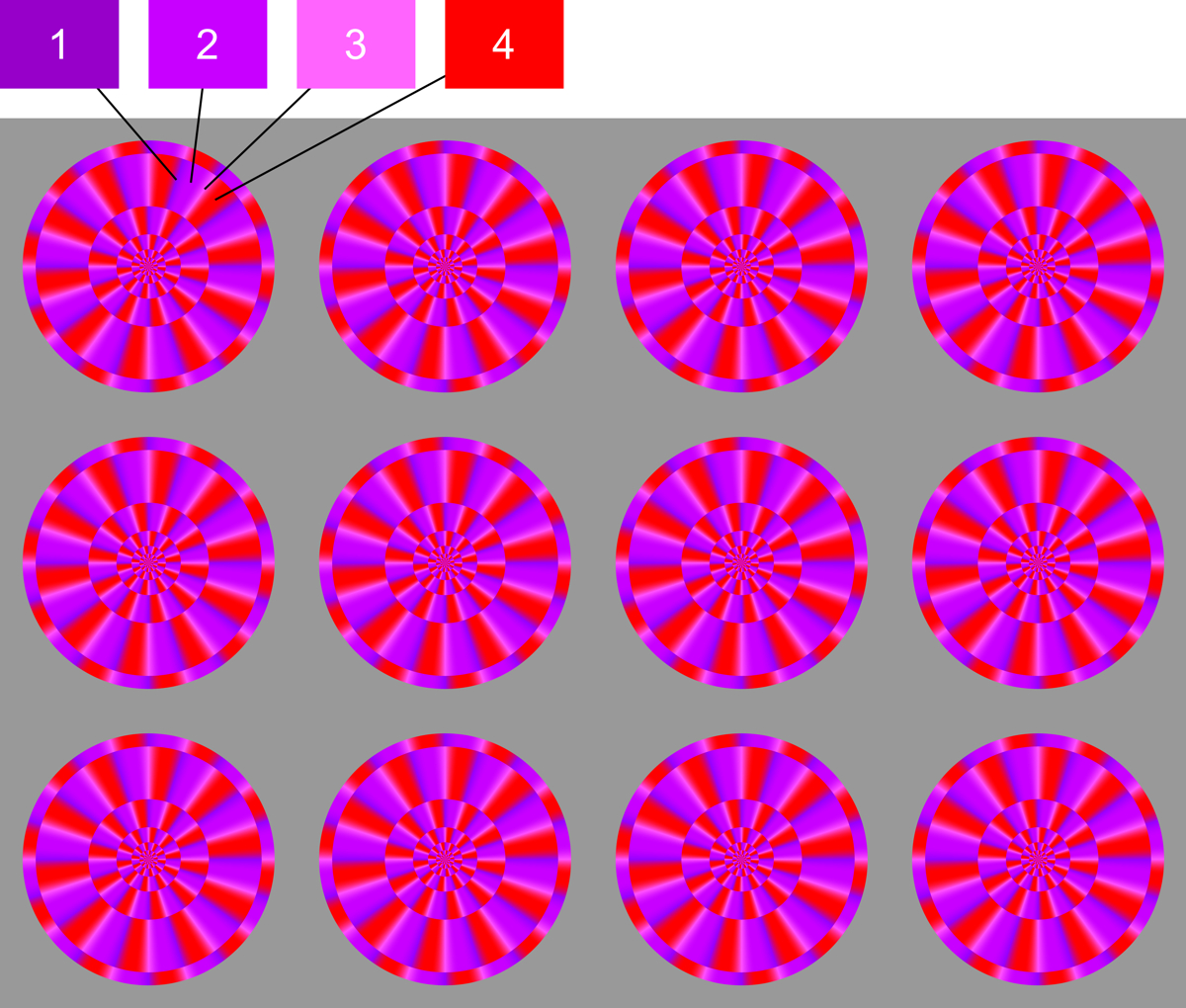
Figure 6 of Kitaoka, A. (2014). Color-dependent motion illusions in stationary
images and their phenomenal dimorphism. Perception, 43(9), 914-925.
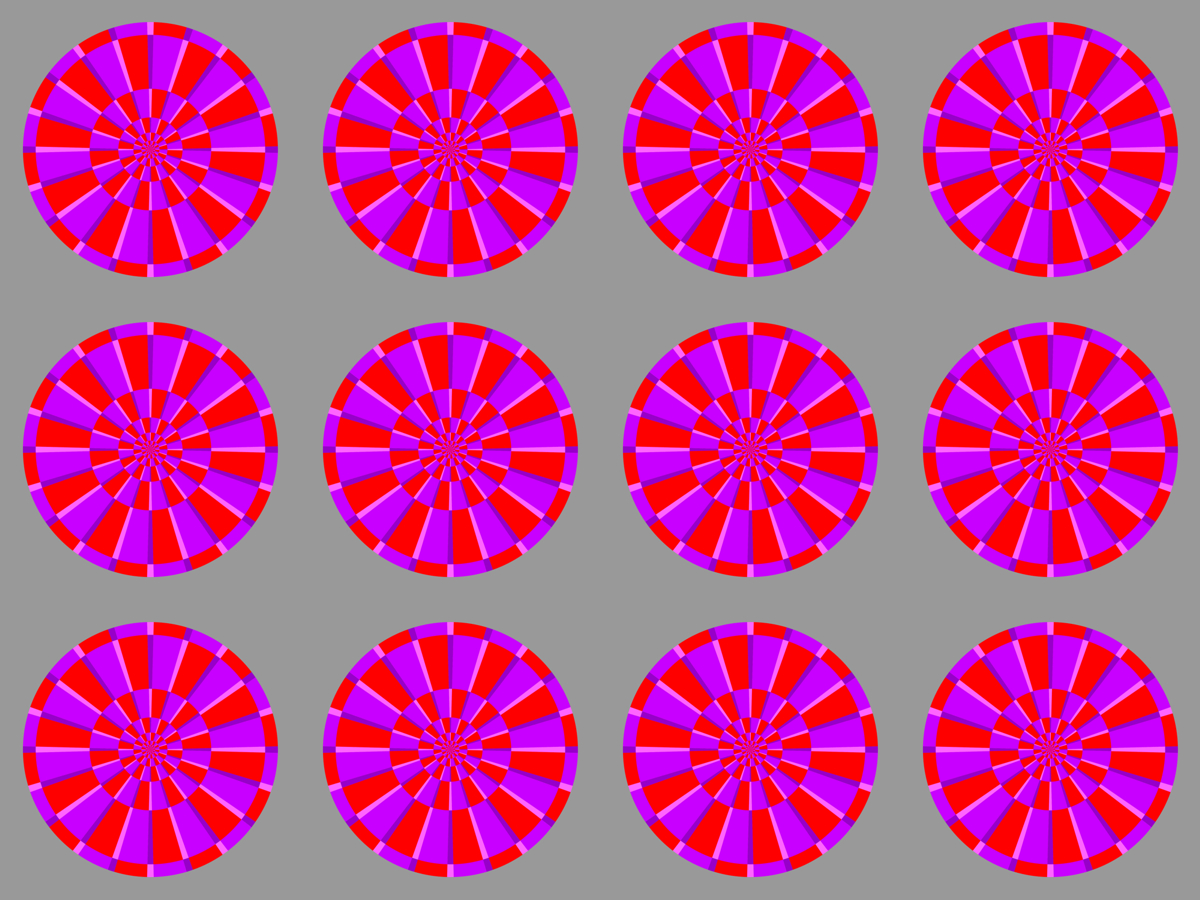
Illusion remains when the image is not blurred.
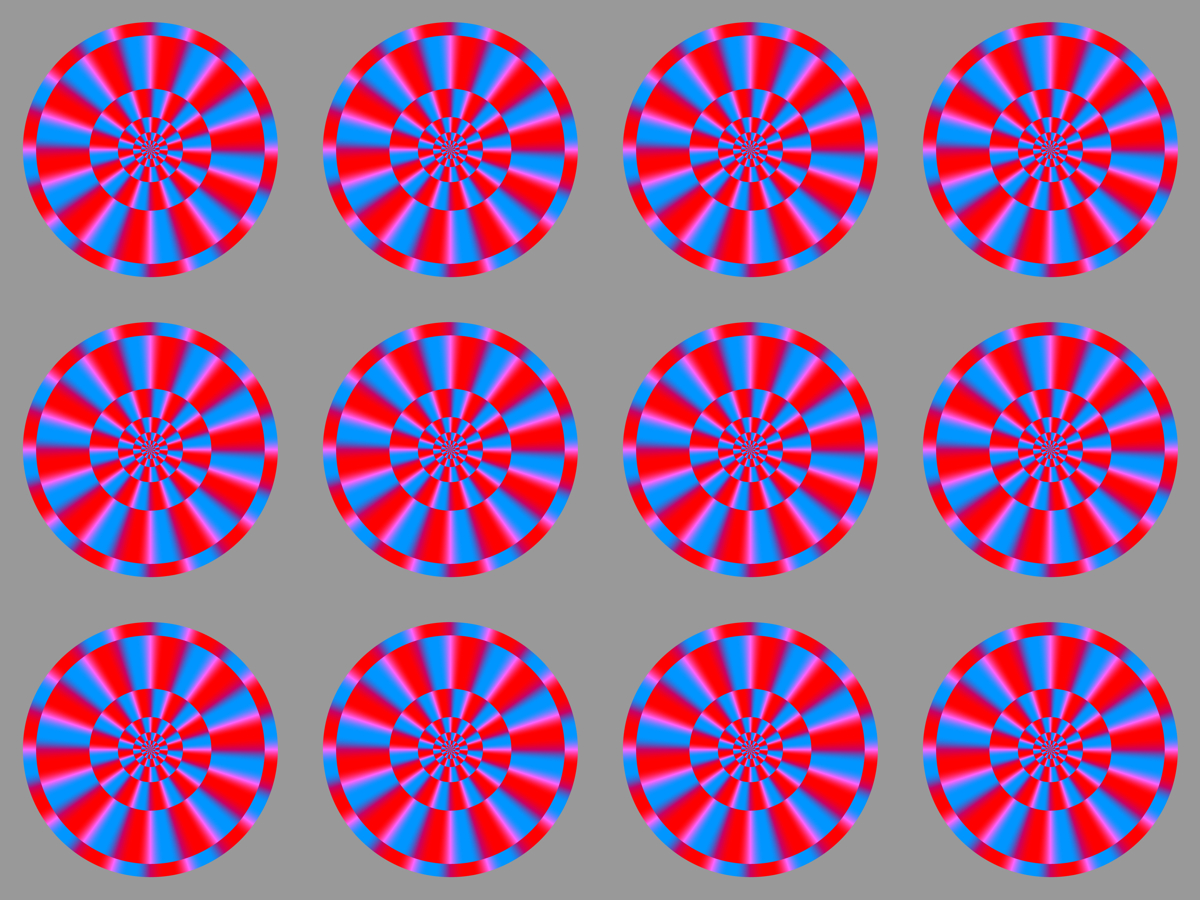
Illusion occurs with red and blue.
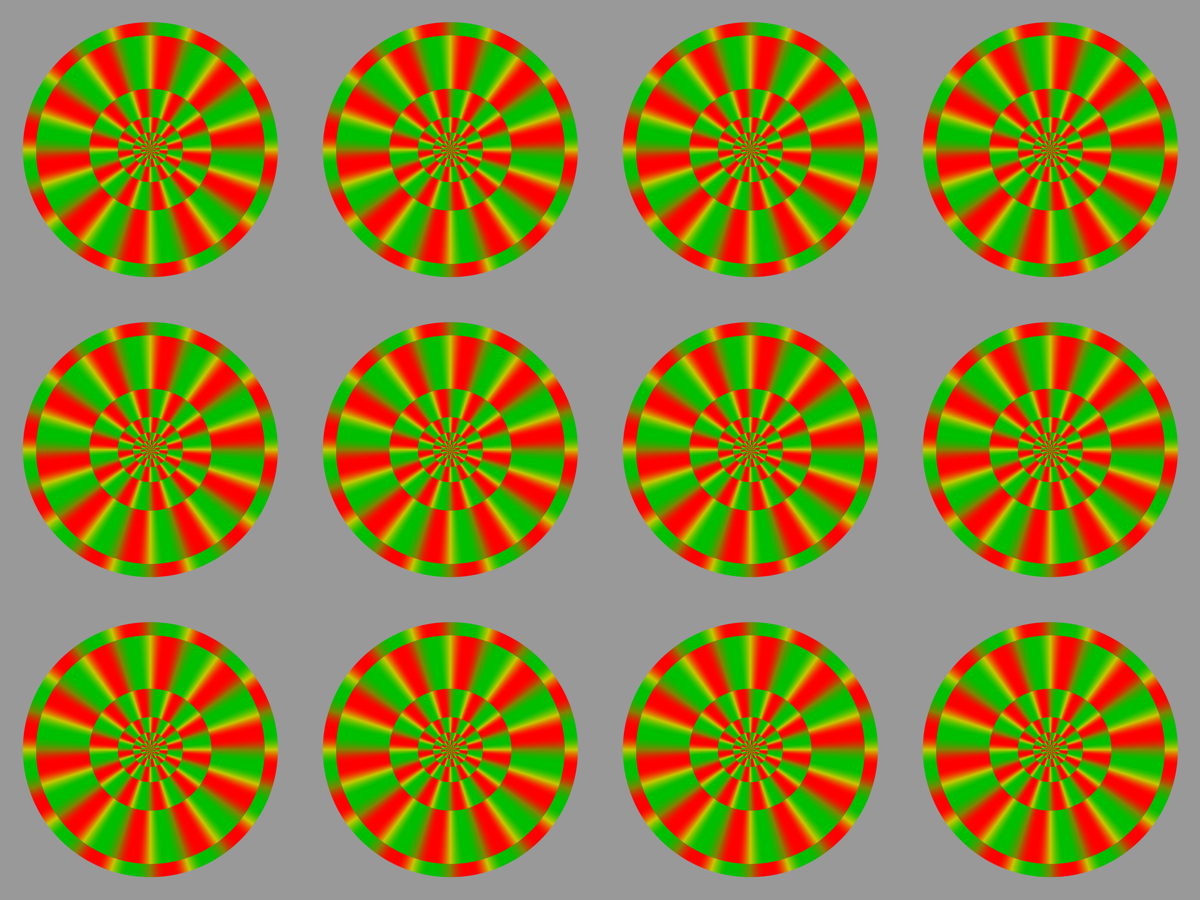
Illusion occurs with red and green.
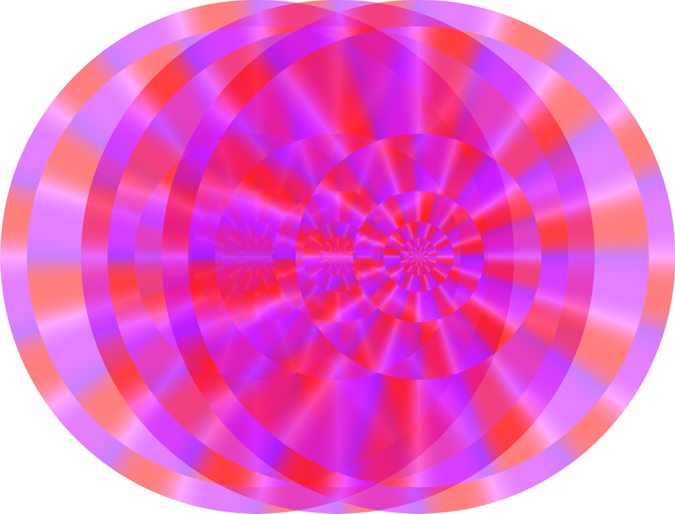
Illusion is triggered by moving images, blinks or eye movements.
Yanaka, K. and Hilano, T. (2011). Mechanical shaking system to enhance "Optimized Fraser–Wilcox Illusion Type V". Perception, 40, ECVP Abstract Supplement, page 171.
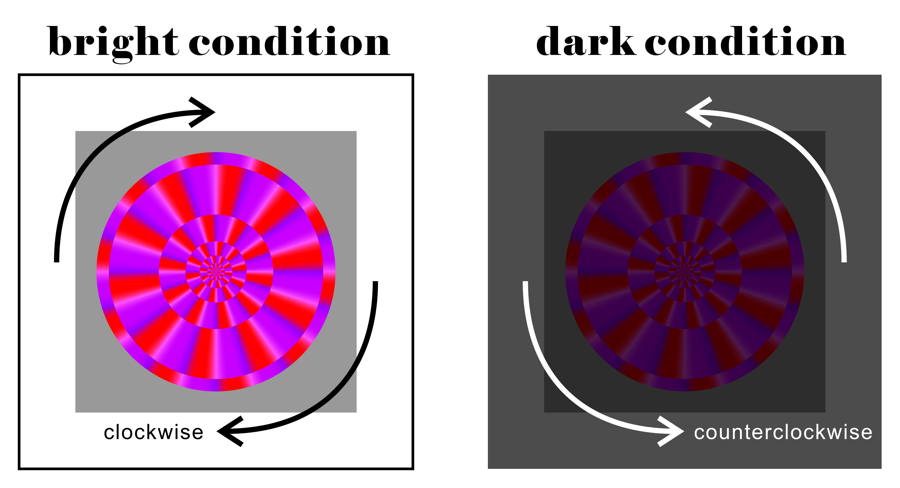
Illusion is reversed depending on luminance or light/dark adaptation.
Kitaoka, A. and Yanaka, H. (2013). Reversal of the color-dependent Fraser-Wilcox illusion under a dark condition. Perception 42 (36th) ECVP (Bremen) Abstract Supplement, page 97 (Poster August 27, 2013). Poster PDF
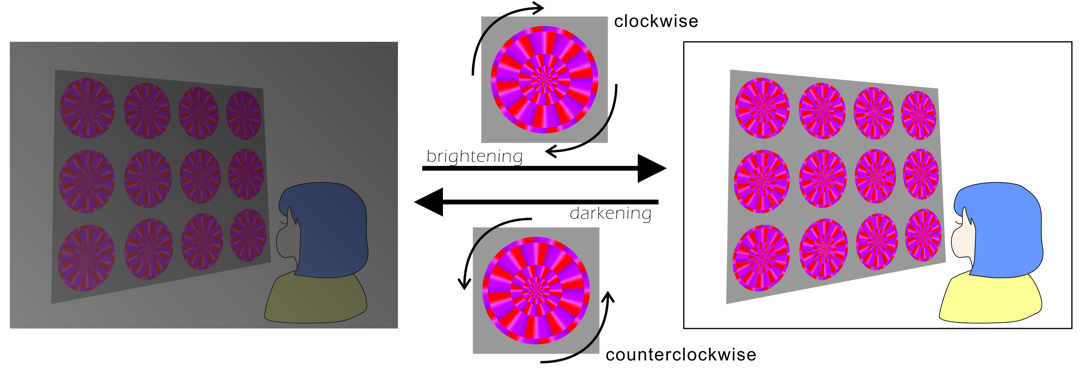
Illusion is reversed depending on the change of luminance.
Kitaoka, A. and Yanaka, H. (2013). Reversal of the color-dependent Fraser-Wilcox illusion under a dark condition. Perception 42 (36th) ECVP (Bremen) Abstract Supplement, page 97 (Poster August 27, 2013). Poster PDF

Kitaoka (2013)
It is suggested that this ‘luminance change-induced’ motion* might generate
the color-dependent Fraser-Wilcox illusion, being triggered by saccades,
blinks, flickering or shaking the images.
*The luminance change-induced’ motion includes the reverse phi phenomenon
(Anstis, 1970; Anstis and Rogers, 1975) and the phenomenal phenomena (Gregory
and Heard, 1983). Directions of illusory motion depending on the changes
of luminance are shown in the right (Kitaoka, 2006).
References
Anstis S M, 1970 “Phi movement as a subtraction process” Vision Research 10 1411-1430
Anstis S M, Rogers B J, 1975 “Illusory reversal of visual depth and movement
during changes of contrast” Vision Research 15 957-961
Gregory R L, Heard P F, 1983 “Visual dissociations of movement, position,
and stereo depth: some phenomenal phenomena” Quarterly Journal of Experimental
Psychology 35A 217-237
Kitaoka, A. (2006). Configurational coincidence among six phenomena: A
comment on van Lier and Csathó (2006). Perception,
35, 799-806. animations --- PDF
"Rotating gray-scale disks (movie)"
Disks appear to rotate clockwise or counterclockwise.
Copyright Akiyoshi Kitaoka 2013 (February 15)
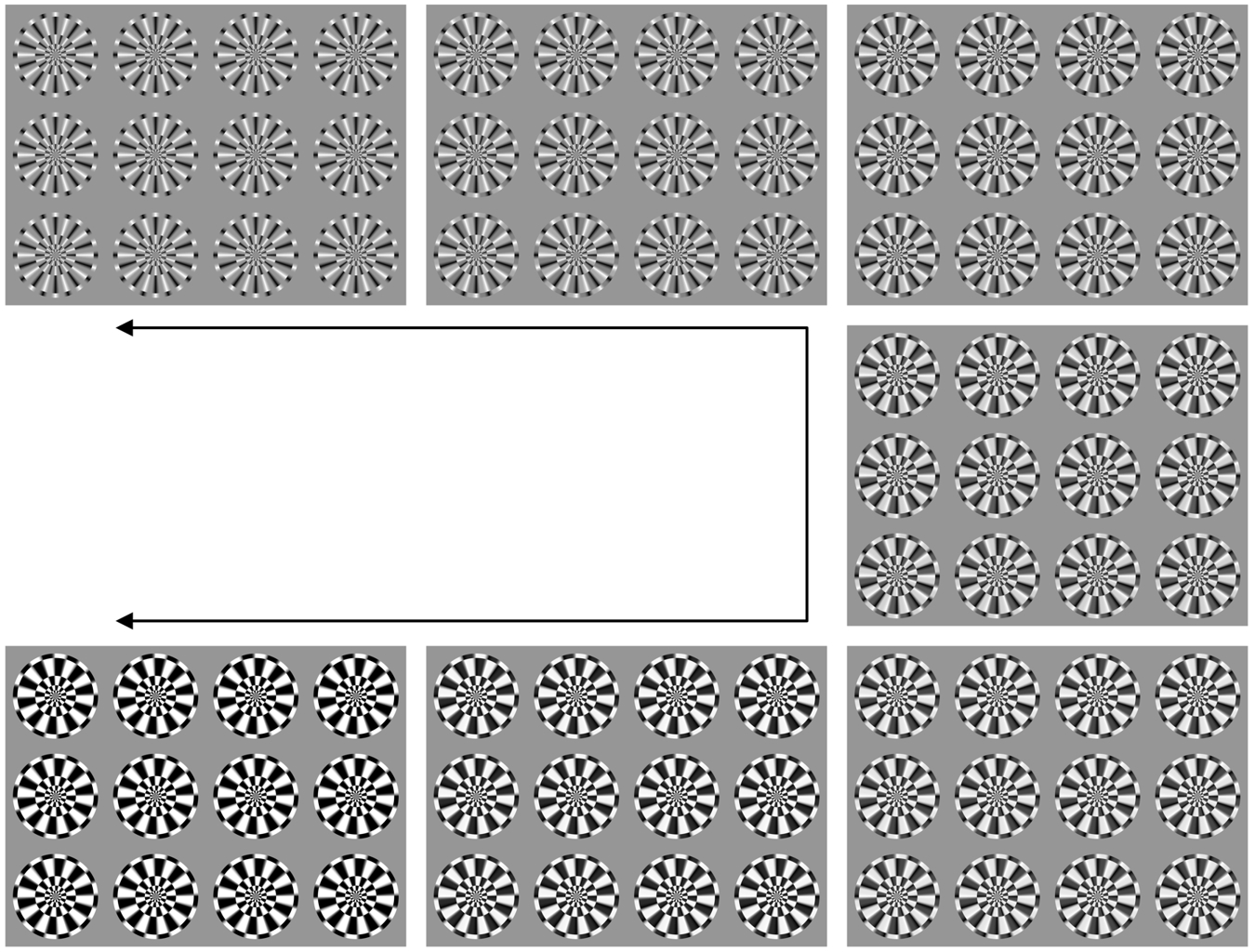
輝度変調誘導性の運動錯視
luminance change-induced motion illusion
Configurational coincidence among six phenomena: A comment to van Lier
and Csathó (2006)
Kitaoka, A. (2006). Configurational coincidence among six phenomena: A comment on van Lier and Csathó (2006). Perception, 35, 799-806. animations --- PDF
Adobe Flash Player is necessary to play animations on this page.
Animation 1
Reversed phi movement (Anstis and Rogers 1975). There are four rectangles, each of which is flanked by thin lines that are dark or light. When the luminance of the rectangles decreases and that of the background increases accordingly, the upper two appear to converge in motion while the lower two appear to go apart in motion. On the other hand, when the luminance of the rectangles increases and that of the background decreases accordingly, the upper two appear to go apart in motion while the lower two appear to approach each other in motion. In sum, the direction of apparent motion is from the dark flank to the neighboring part that goes darkening or from the light flank to the neighboring part that goes brightening. Although the rectangles are aligned vertically, the apparent positional displacement occurs in the opposite direction to motion. If observers cross-fuse (uncross-fuse) the right and left rectangles, the upper rectangle appears to be in front of (behind) the lower one when they are dark.
Animation 2
The illusory motion investigated by Gregory and Heard (1983). This appearance is quite similar to Animation 1. The only configurational difference from the reversed phi movement is that the luminance of the rectangles is constant.
Animation 3
The illusory motion mentioned by Gregory and Heard (1983), in which the luminance of the rectangles dynamically changes while that of the surround is constant. This appearance is quite similar to Animations 1 and 2.
Animation 4
Phi movement (Anstis and Rogers 1975). For panel (a), dark stationary rectangles are placed on a bright stationary background. When the luminance of the right flank of each rectangle increases and that of the left flank decreases, the rectangle appears to shift leftward in motion as well as in position. Conversely, the luminance of the right flank decreases and that of the left flank increases, the rectangle appears to shift rightward in motion and position. If observers cross-fuse (uncross-fuse) the right and left rectangles, the fused rectangle appears to be in front (behind) when the right flank of the right rectangle are dark and the left flank of the left rectangle are dark. For panel (b), bright rectangles are placed on a dark background. In this case, phenomena are the reversal of panel (a).
(a) (b)
(a) Flash(swf) --- QuickTime(mov)
(b) Flash(swf) --- QuickTime(mov)
Animation 5
Consistency between the reversed phi movement and stereopsis (Anstis and Rogers 1975). In this animation, there are two phases in motion, in which the upper-left and the lower-right rectangles are one eighth phase in advance of the upper-right and the lower-left rectangles. For example, when the luminance of the rectangles increases, the upper-left rectangle appear to go leftward followed by the upper-right one, while the lower-right rectangle appear to go leftward followed by the lower-left one. In this period, the cross-fused (uncross-fused) upper rectangle appears to be in front (behind) as compared with the cross-fused (uncross-fused) lower rectangle.
Animation 6
Consistency between the apparent motion and Café-Wall-like tilt illusions (van Lier and Csathó 2005). According to dynamic changes in luminance gradient, the flanks of the rectangle appears to tilt dynamically. (a) The luminance gradient given to both flanks is dynamically changed while the dark-gray rectangle and the light-gray background are stationary. The dark part of the gradient appears to shift outward in motion and position while the bright part appears to shift inward in motion and position. This distortion agrees with the tilt illusion. (b) The luminance gradient given to the rectangle is dynamically changed while the dark flanks and the gray background are stationary. At the dark part of the gradient, the neighboring part of flanks appears to shift inward in motion and position, while at the bright part of the gradient, the neighboring part of flanks appears to shift outward in motion and position. This distortion agrees with the tilt illusion.
(a) (b)
(a) Flash(swf) --- QuickTime(mov)
(b) Flash(swf) --- QuickTime(mov)
Animation 7
Inconsistency between the apparent motion and Café-Wall-like tilt illusions. According to dynamic changes in homogenous areas, the flanks of the rectangle appears to tilt dynamically. (a) The luminance of the homogeneous rectangle is dynamically changed while the flanks with luminance gradient and the gray background are stationary. The darkening rectangle appears to attract the dark parts of the flanks inward in motion while the brightening rectangles appears to attract the light parts of the flanks inward in motion. This distortion disagrees with the tilt illusion. (b) The luminance of the homogeneous flanks is dynamically changed while the rectangle with luminance gradient and the gray background are stationary. At the dark part of the gradient, brightening flanks appears to shift inward in motion, while at the bright part of the gradient, darkening flanks appears to shift inward in motion. This distortion disagrees with the tilt illusion
(a) (b)
(a) Flash(swf) --- QuickTime(mov)
(b) Flash(swf) --- QuickTime(mov)
Animation 8
Demonstration of the apparent motion in the three elemental spatio-temporal configurations (Figure 6). The behaviors in (a), (b) and (g) are summarized in Figure 6a (off-center line-type configuration); those in (c), (d) and (h) are in Figure 6b (on-center line-type configuration); and those in (e), (f) and (i) are summarized in Figure 6c (edge-type configuration). For further explanations, see the text.
(a) (b)
(a) Flash(swf) --- Quicklime(mov)
(b) Flash(swf) --- QuickTime(mov)
(c) (d)
(c) Flash(swf) --- QuickTime(mov)
(d) Flash(swf) --- QuickTime(mov)
(e) (f)
(e) Flash(swf) --- QuickTime(mov)
(f) Flash(swf) --- QuickTime(mov)
(g) (h) (i)
(g) Flash(swf) --- QuickTime(mov)
(h) Flash(swf) --- QuickTime(mov)
(i) Flash(swf) --- QuickTime(mov)
Directions of illusory motion depending on changes of luminance in each
area
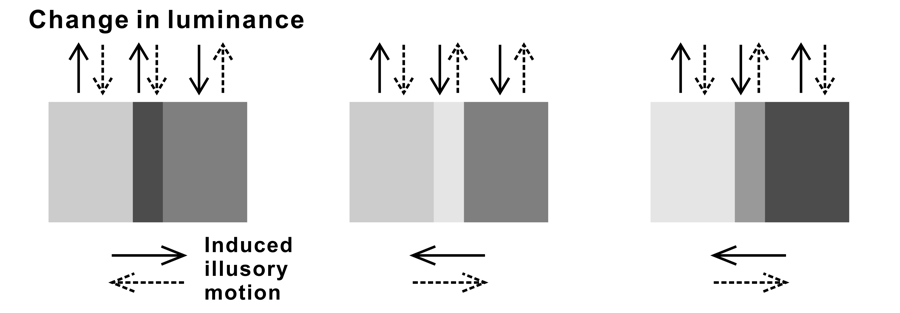
Kitaoka, A. (2006). Configurational coincidence among six phenomena: A comment on van Lier and Csathó (2006). Perception, 35, 799-806. animations --- PDF

Kitaoka, A. (2014). Color-dependent motion illusions in stationary images and their phenomenal dimorphism. Perception, 43(9), 914-925.
考察
1. 明モードではオン反応が錯視に寄与し、暗モードではオフ反応が錯視に寄与する。
2. 明モードのオン反応時には、長波長側(赤)の立ち上がりが短波長側(青)より遅い(遅れて見えてくる)。オフ反応時にはそのような差は少ない。
3. 暗モードのオフ反応時には、長波長側(赤)の立ち下がりが短波長側(青)より遅い(遅れて消えていくように見える)。オフ反応時にはそのような差は少ない。
明モードの条件の時、「急速明順応」すると、暗モードの錯視が短時間観察される(錯視が逆転する)。
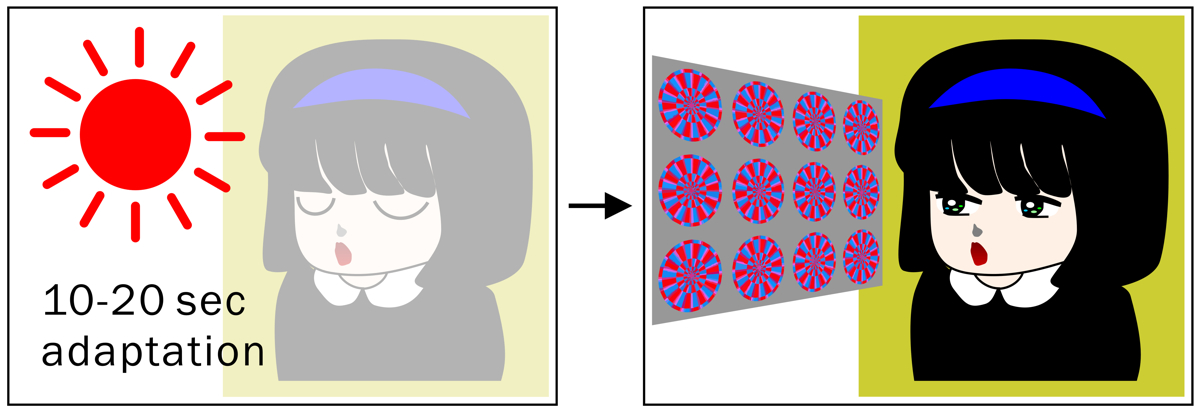
* これは、眼特異的である。*
Speculation
● 色依存のフレーザー・ウィルコックス錯視は、網膜における光応答の立ち上がり・立ち下がりの波長依存の相違が原因。
● その相違が、大脳の運動検出ニューロン(輝度変調依存の運動検出器(今のところ仮想的))を「誤動作」させ、運動の知覚をつくりだす。
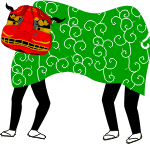 おしまい
おしまい

